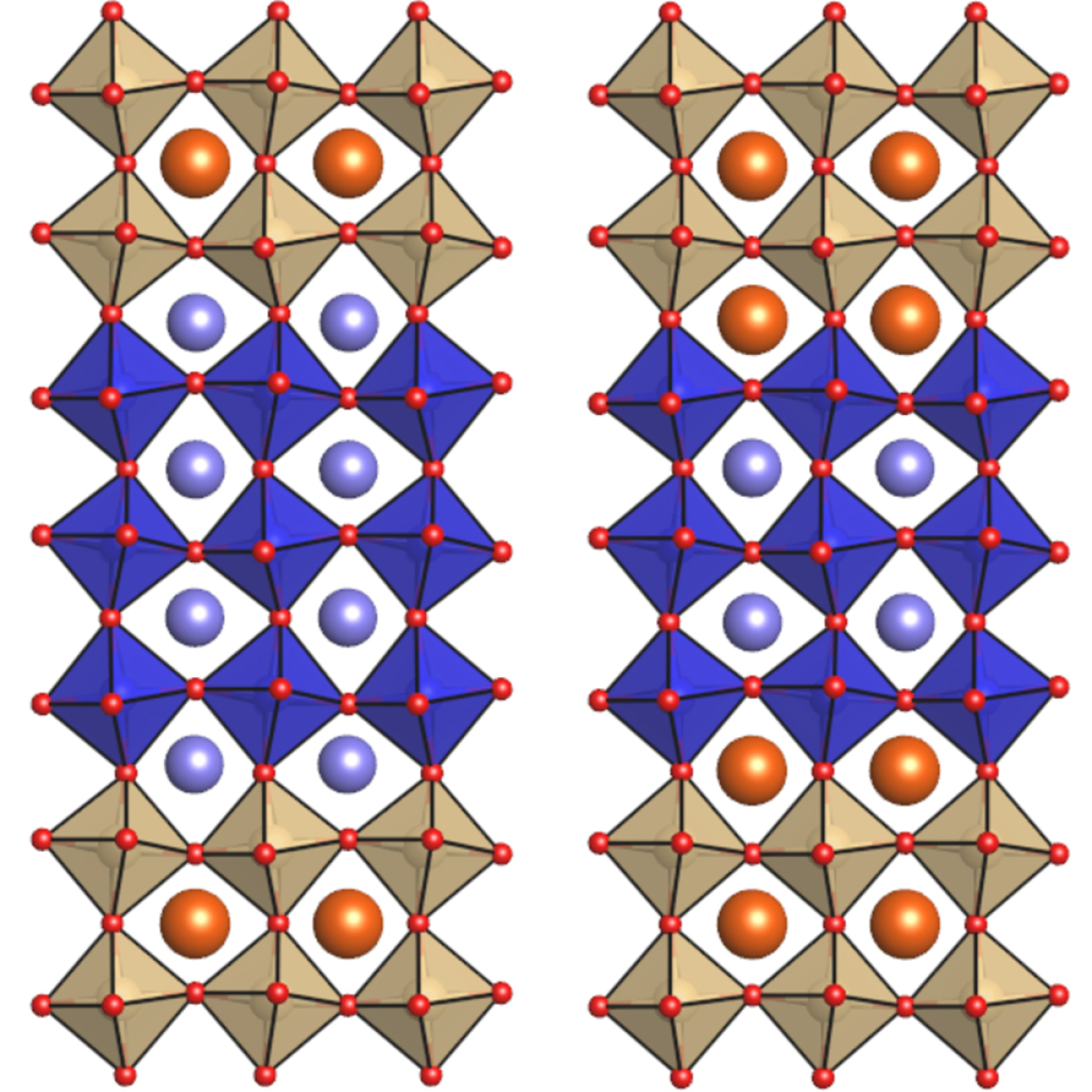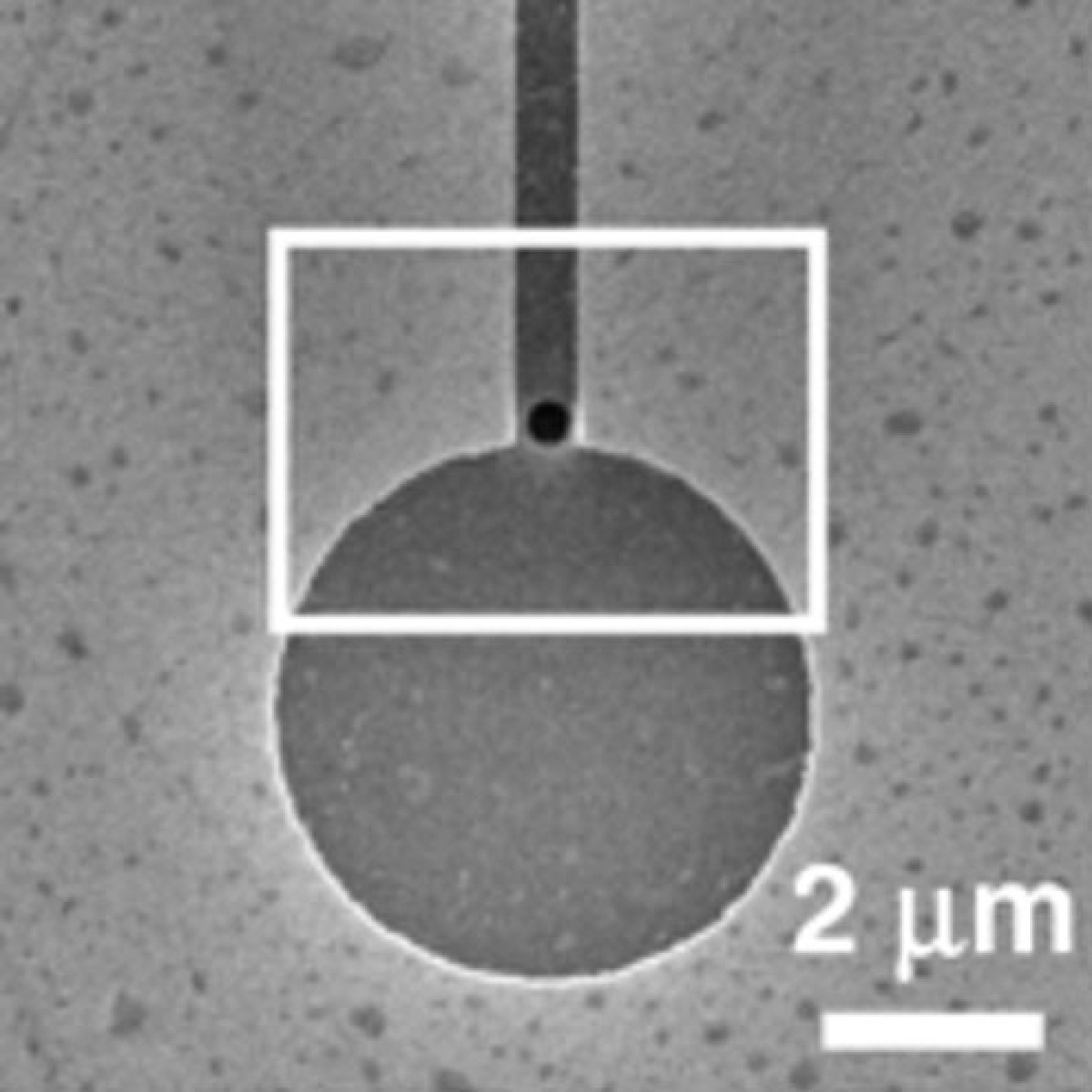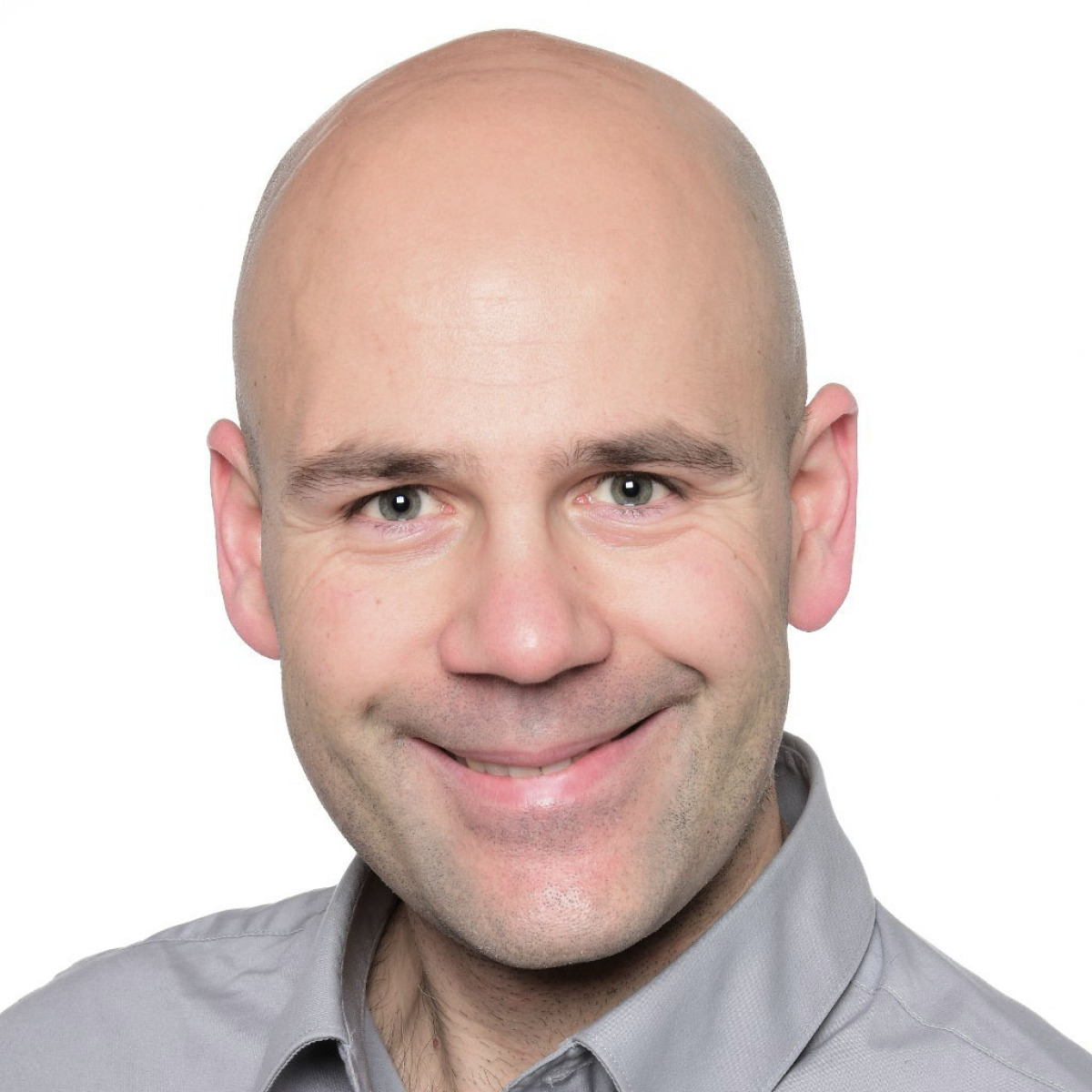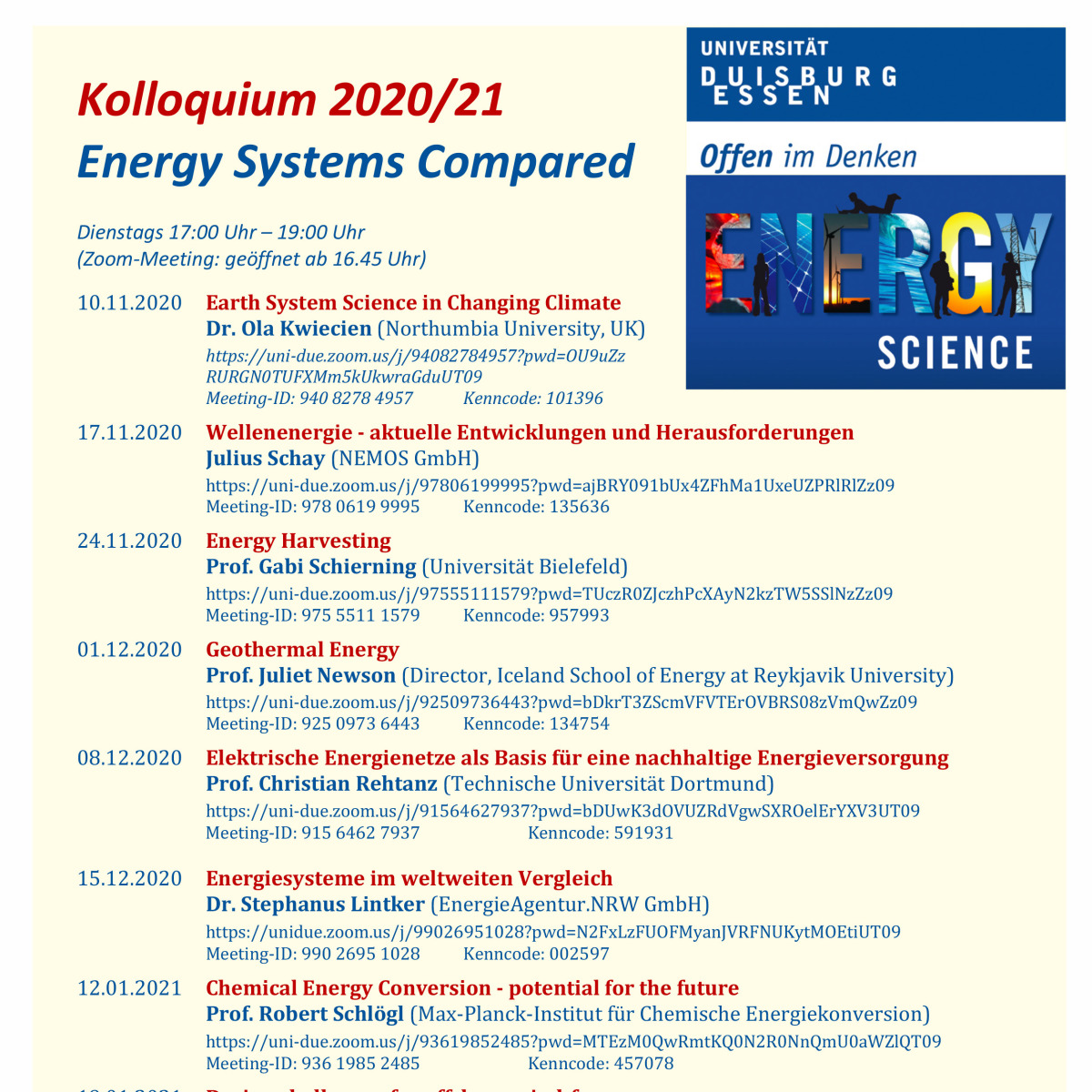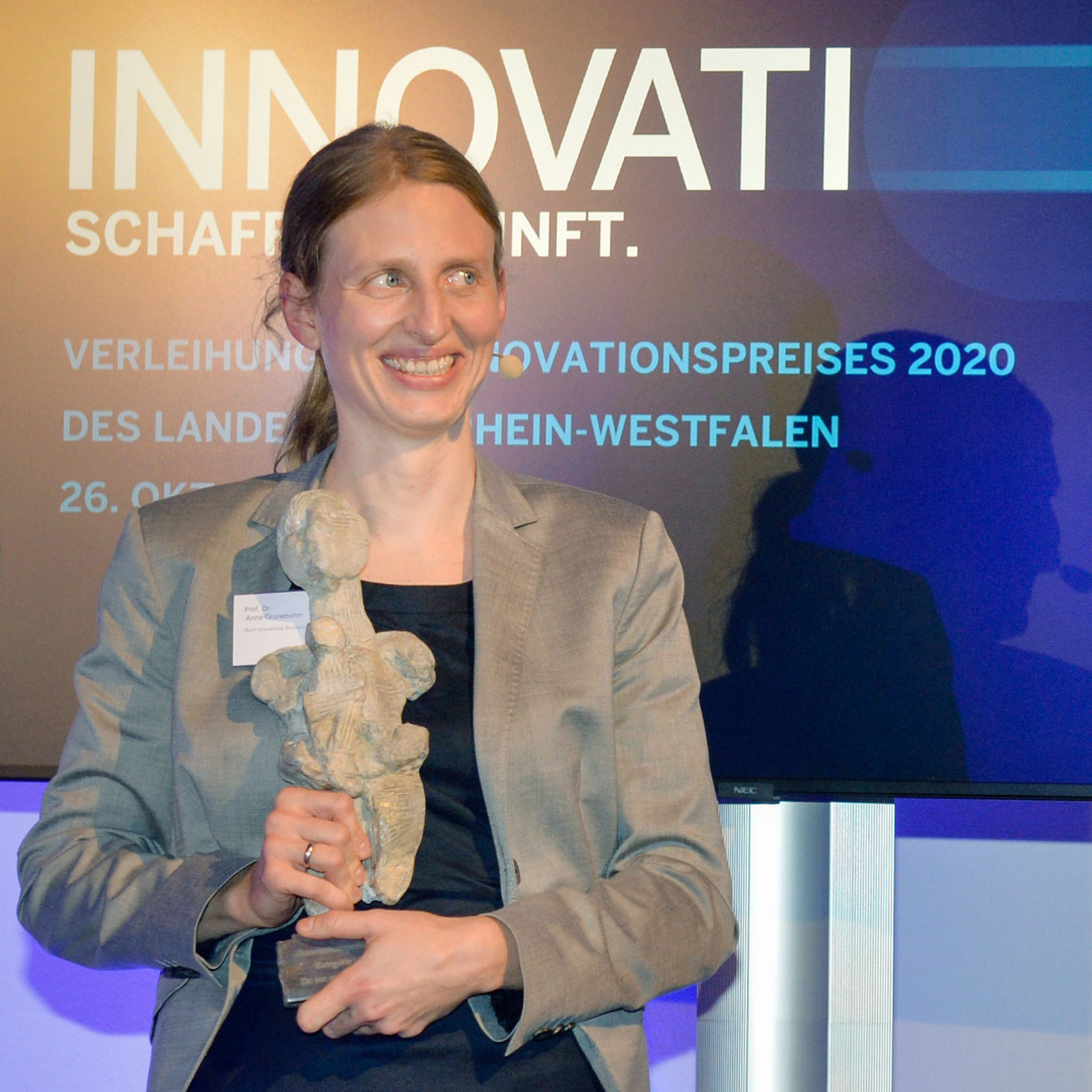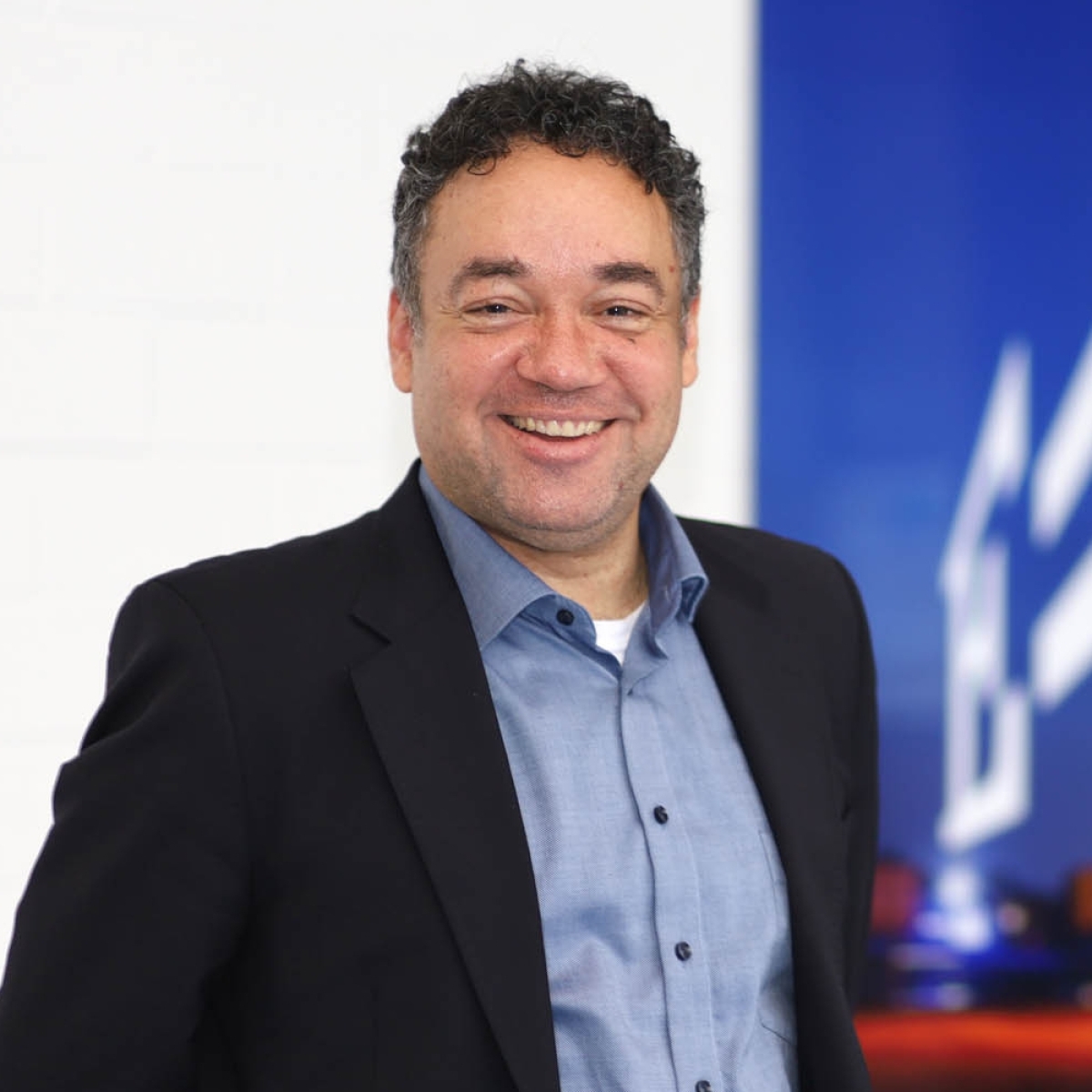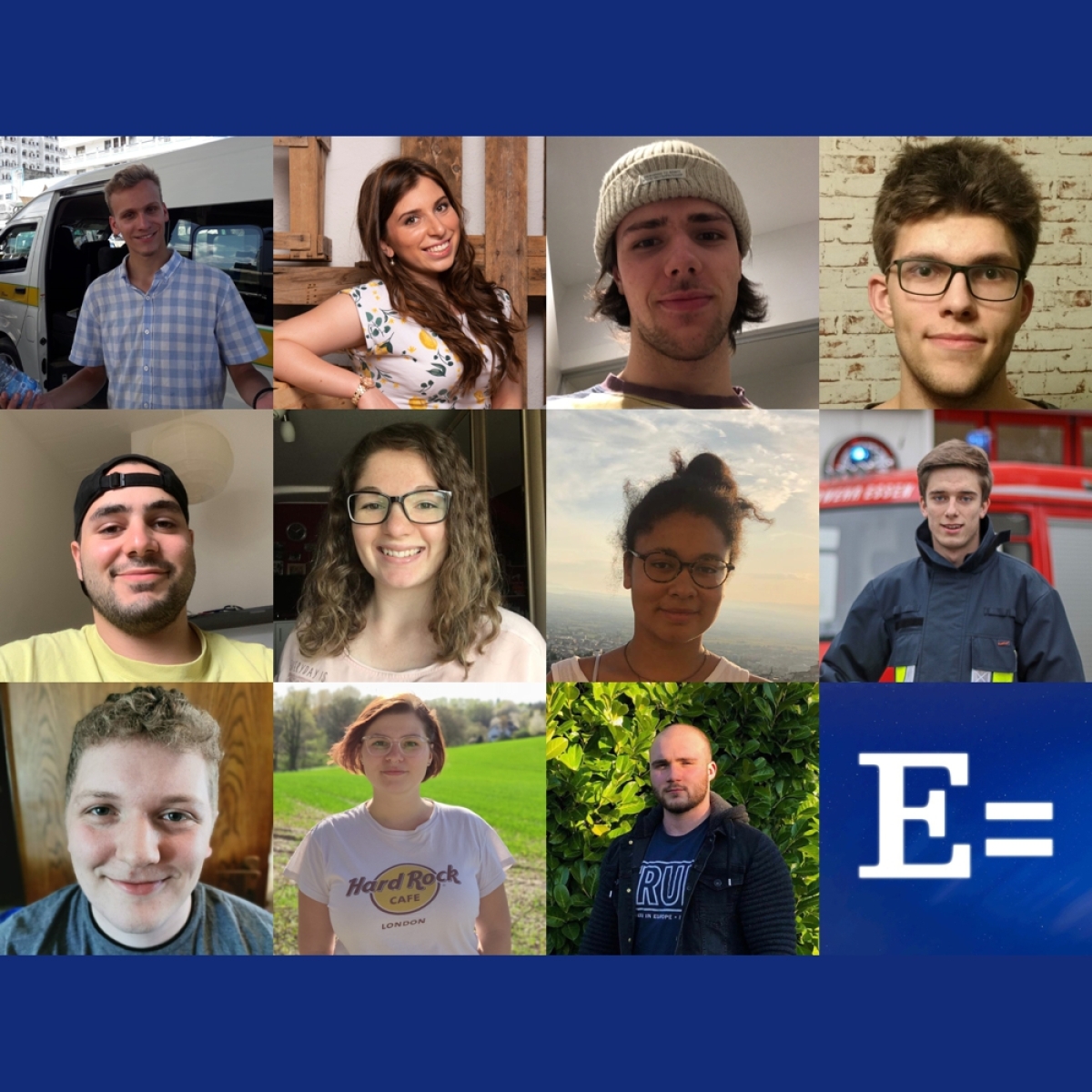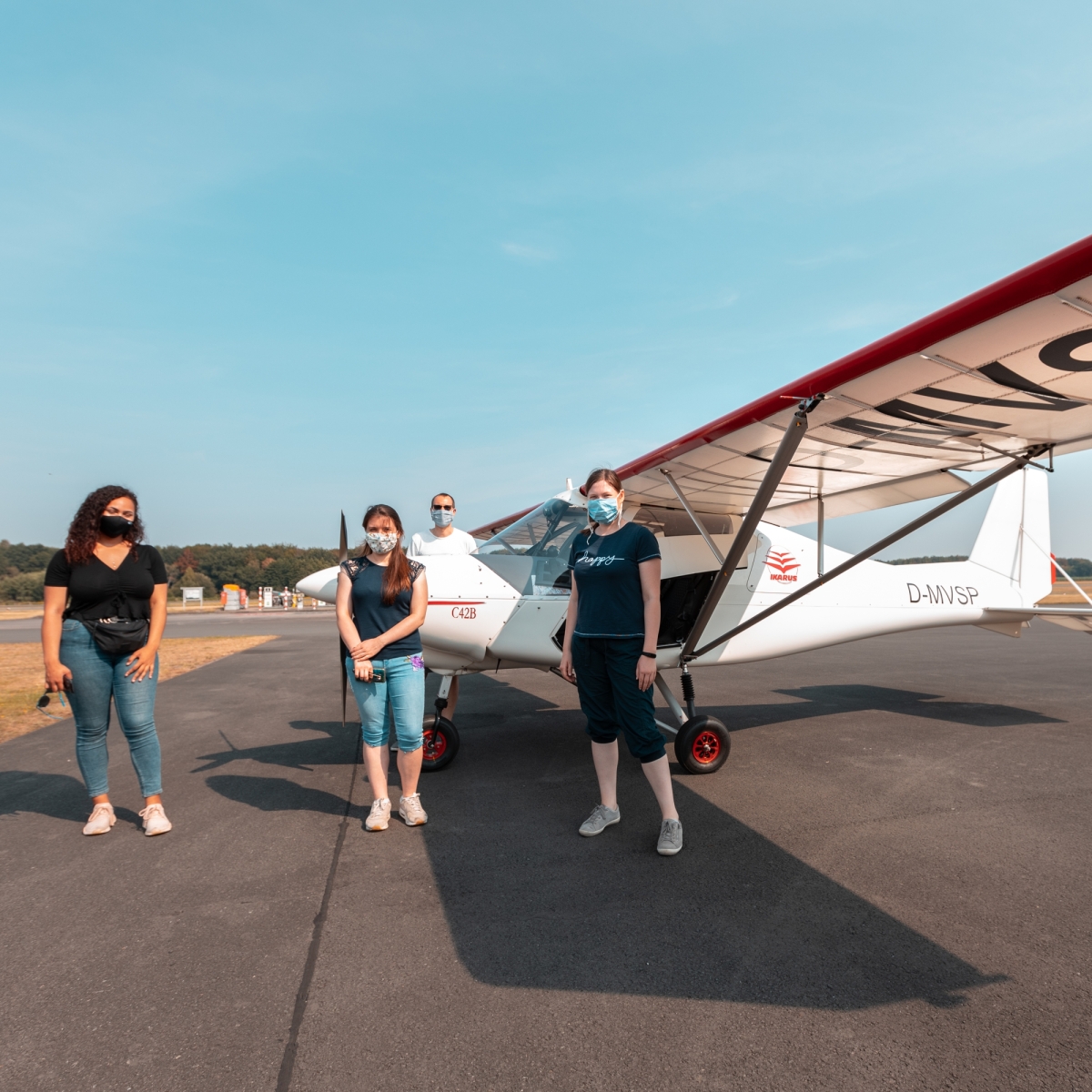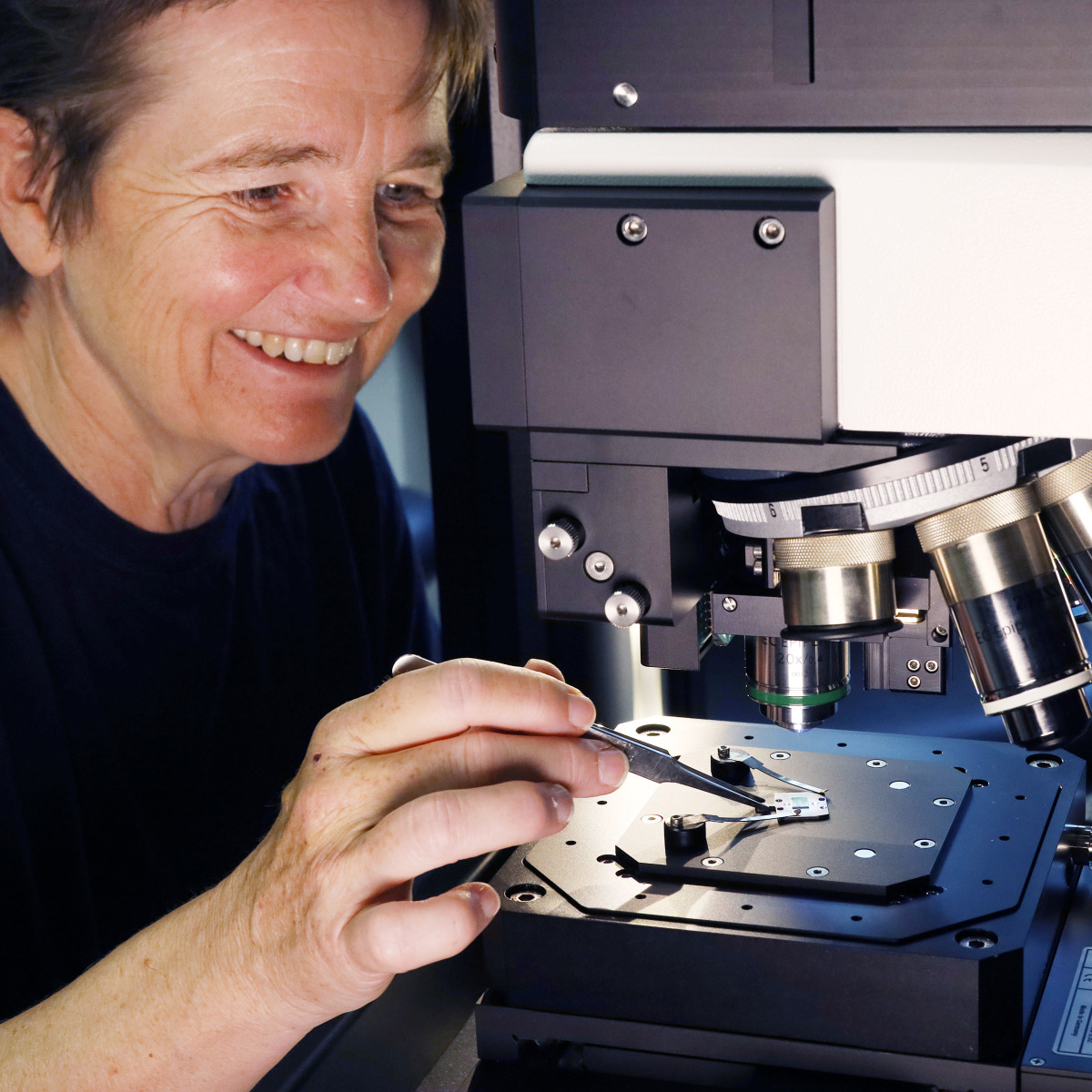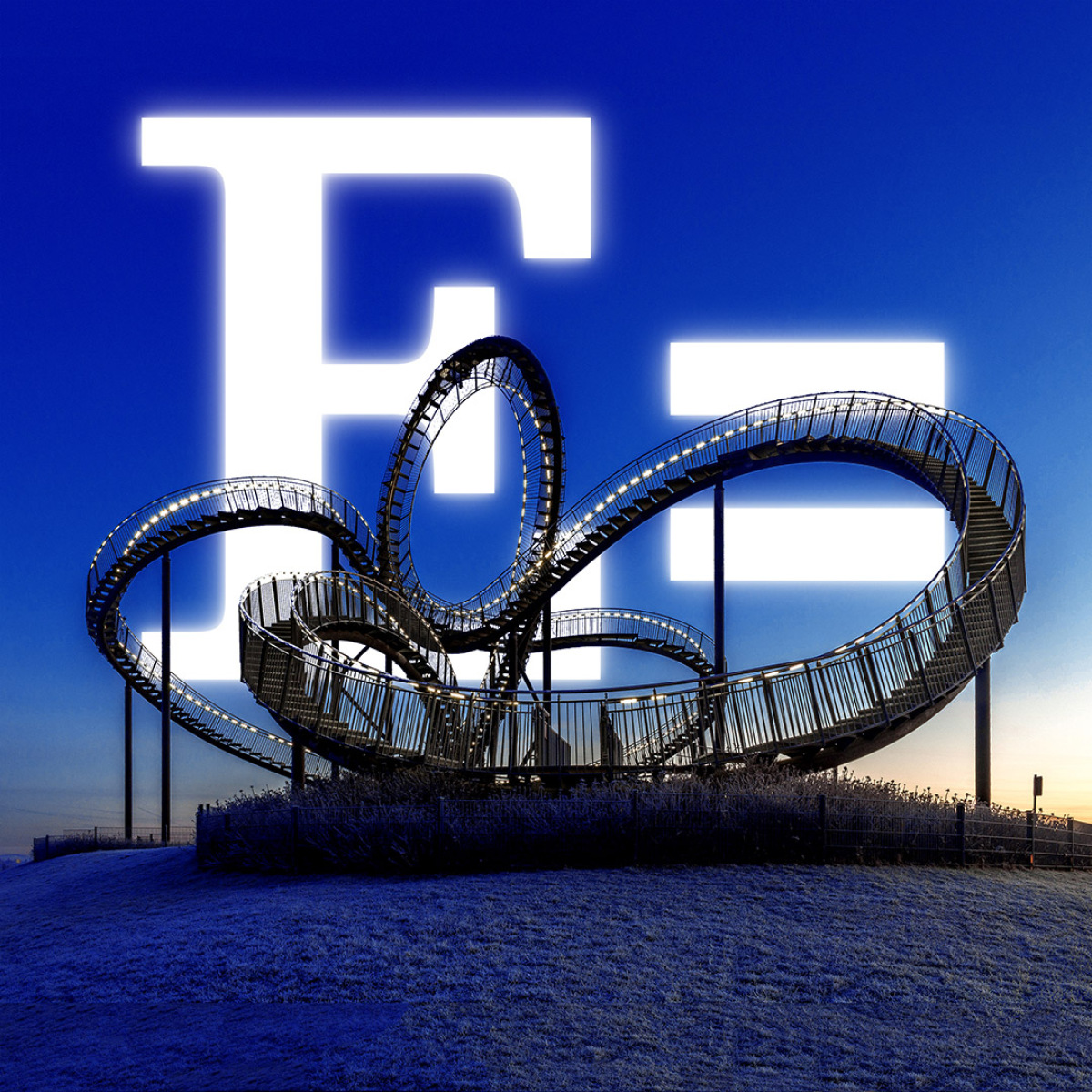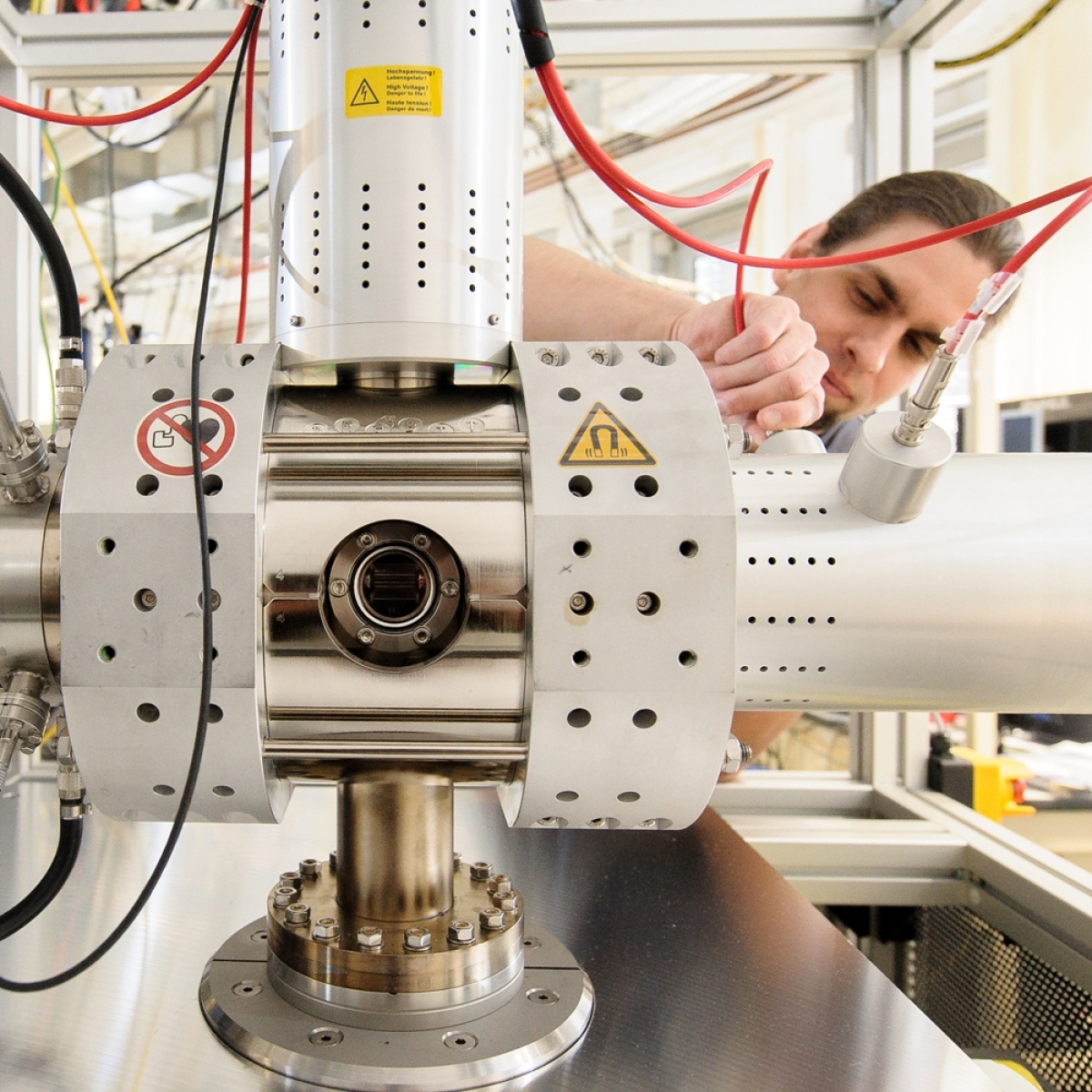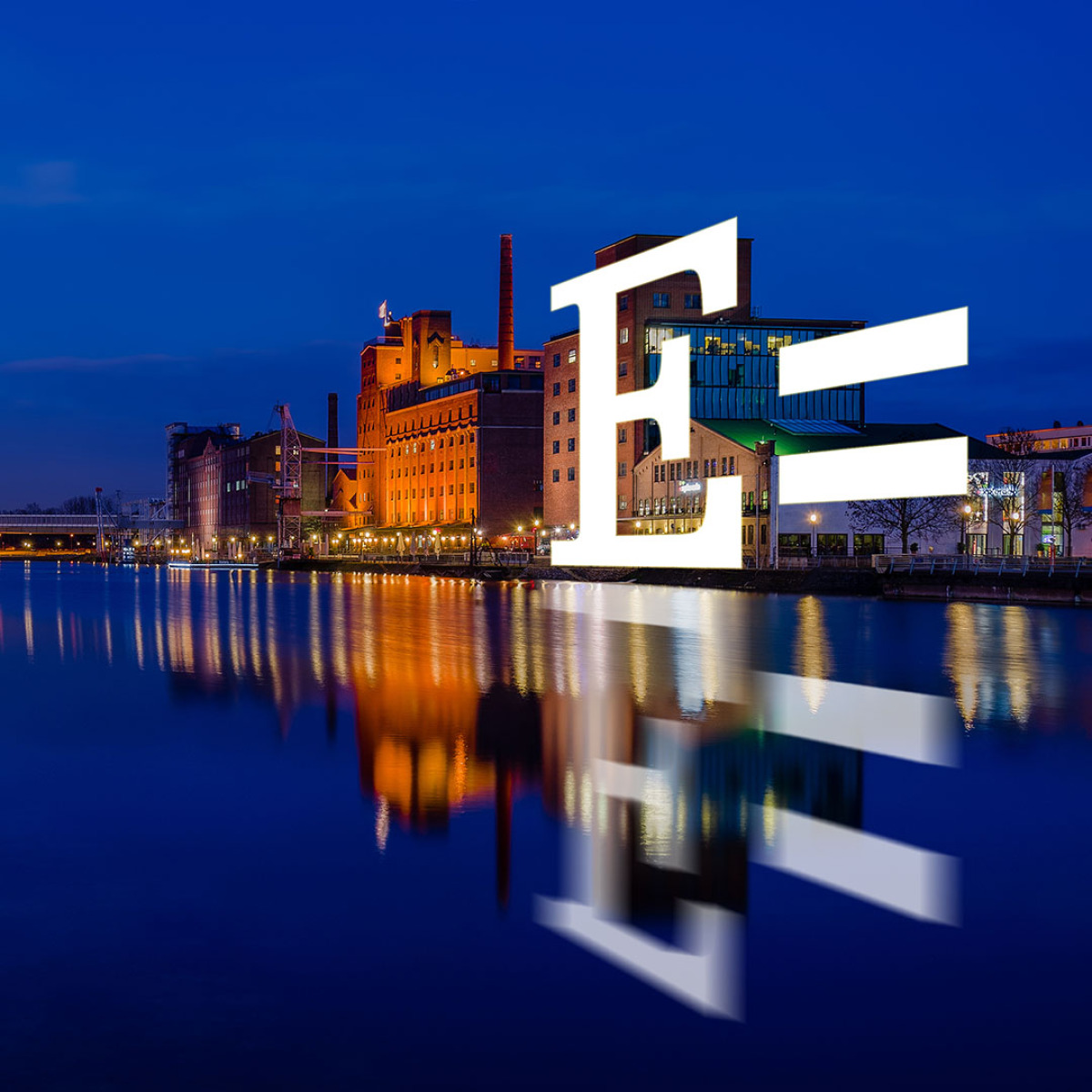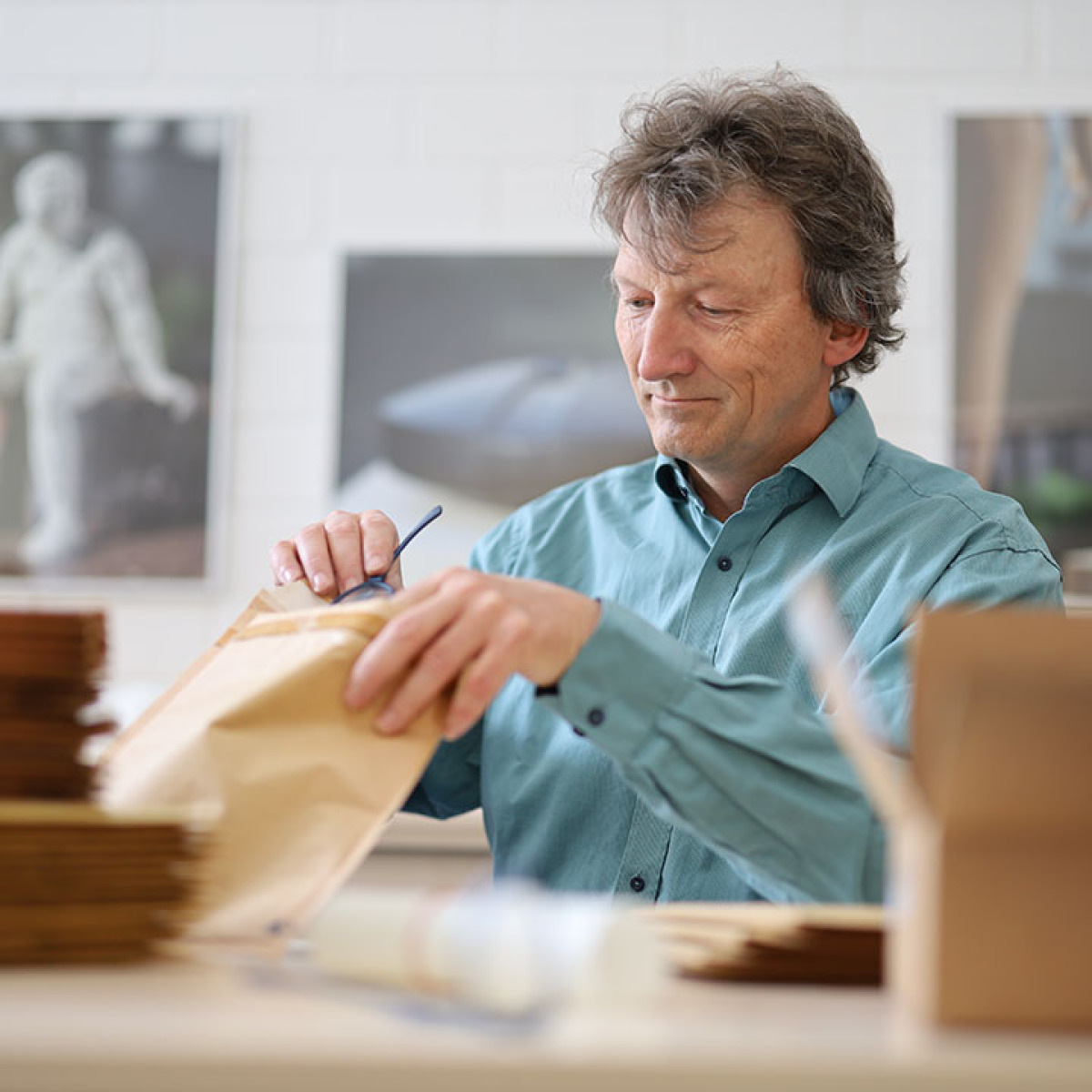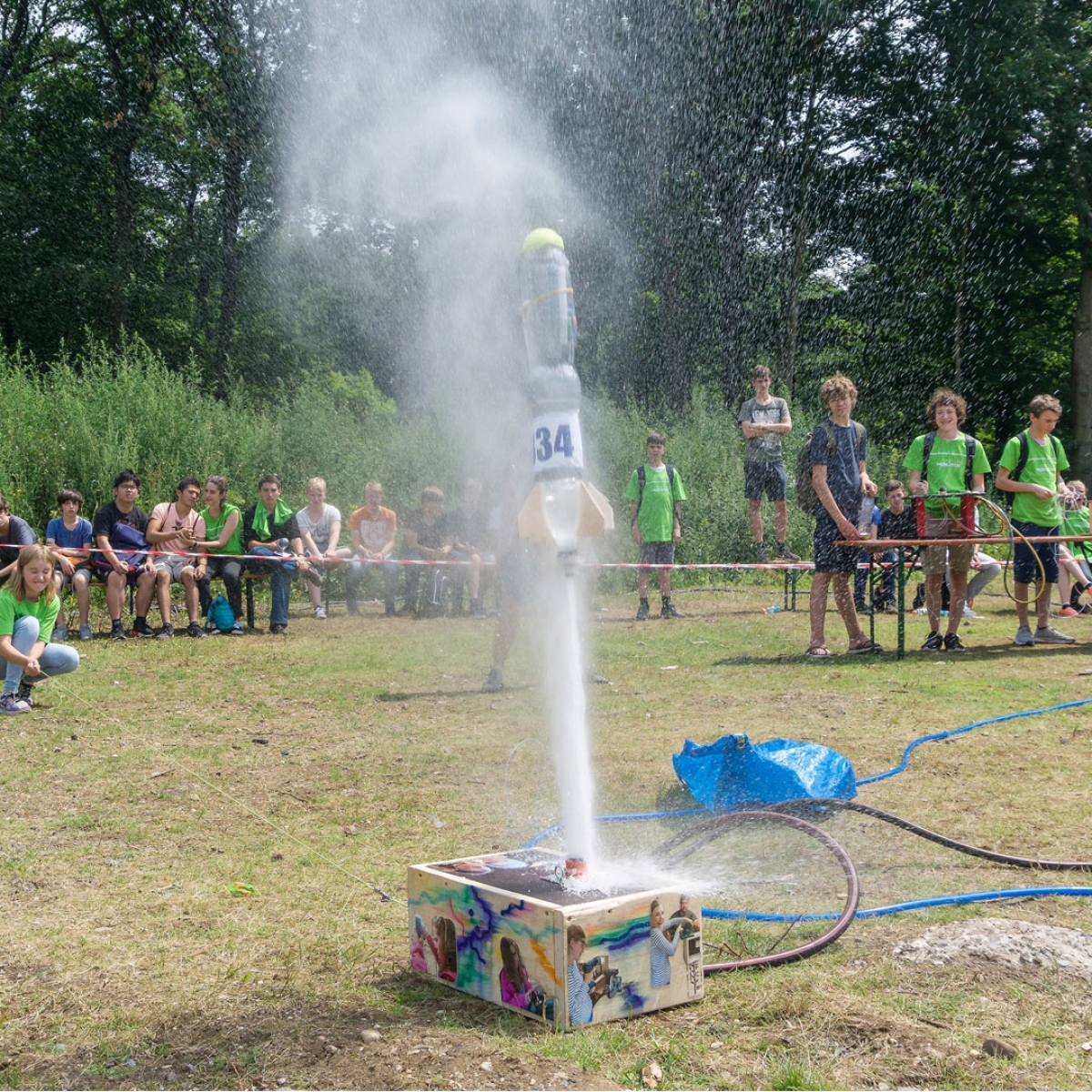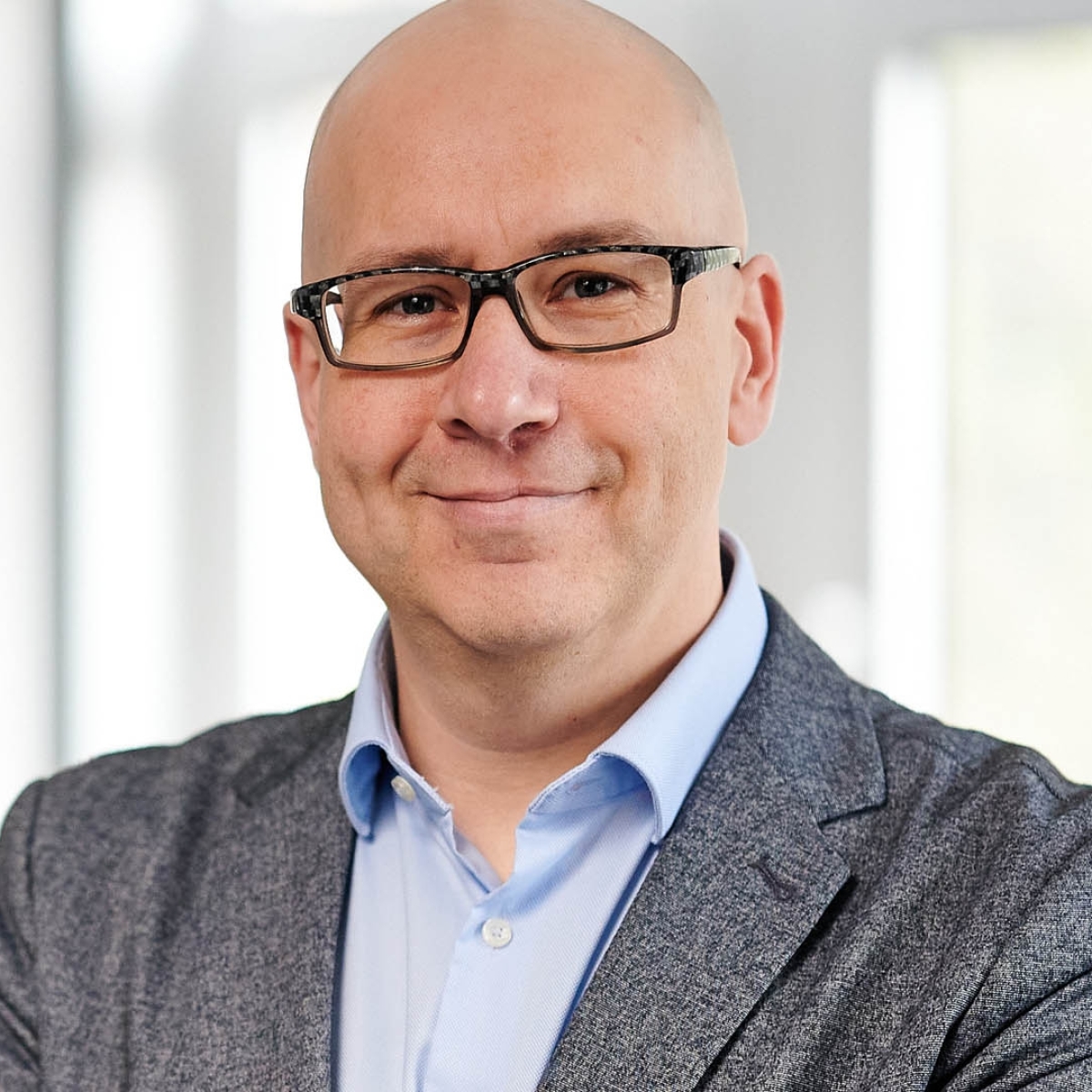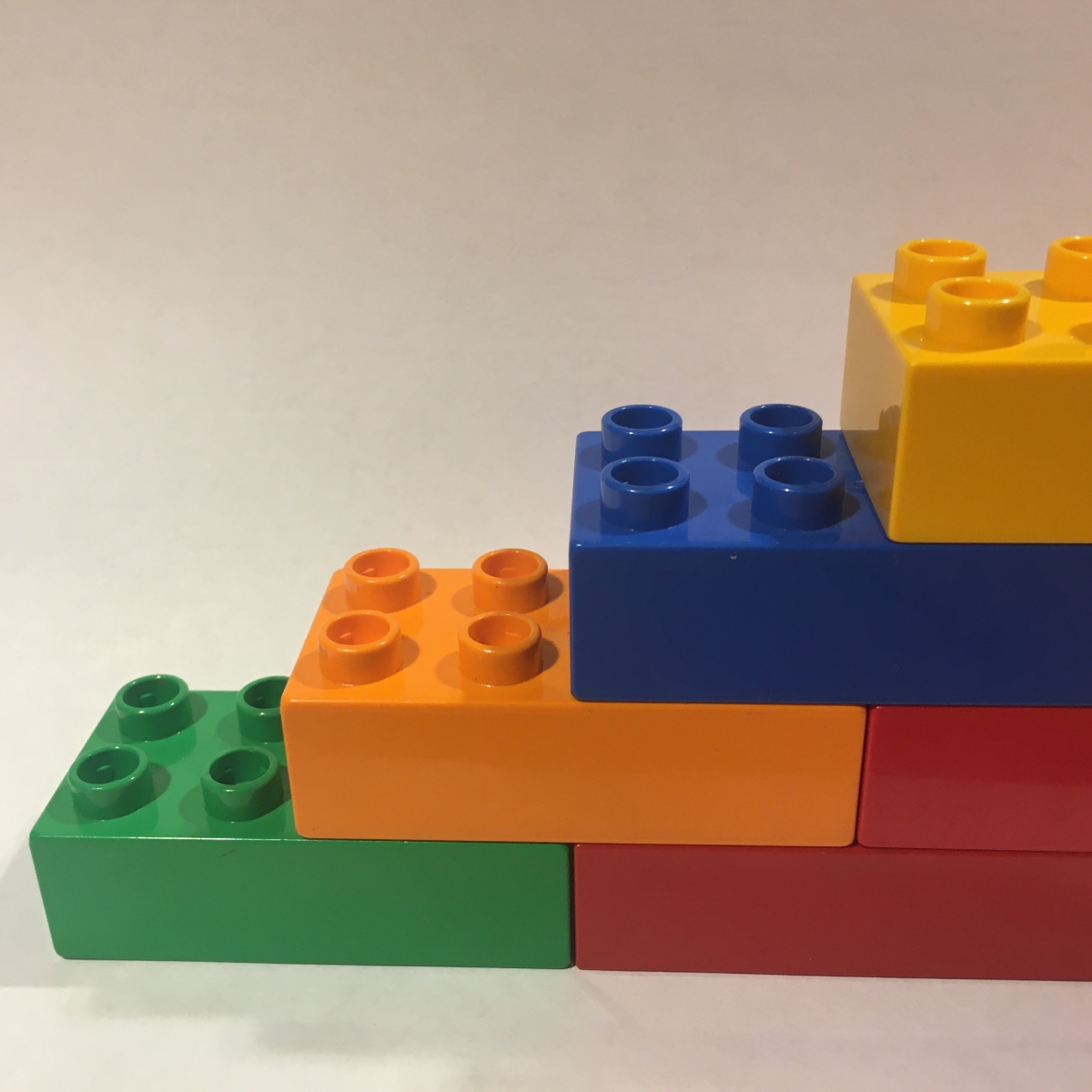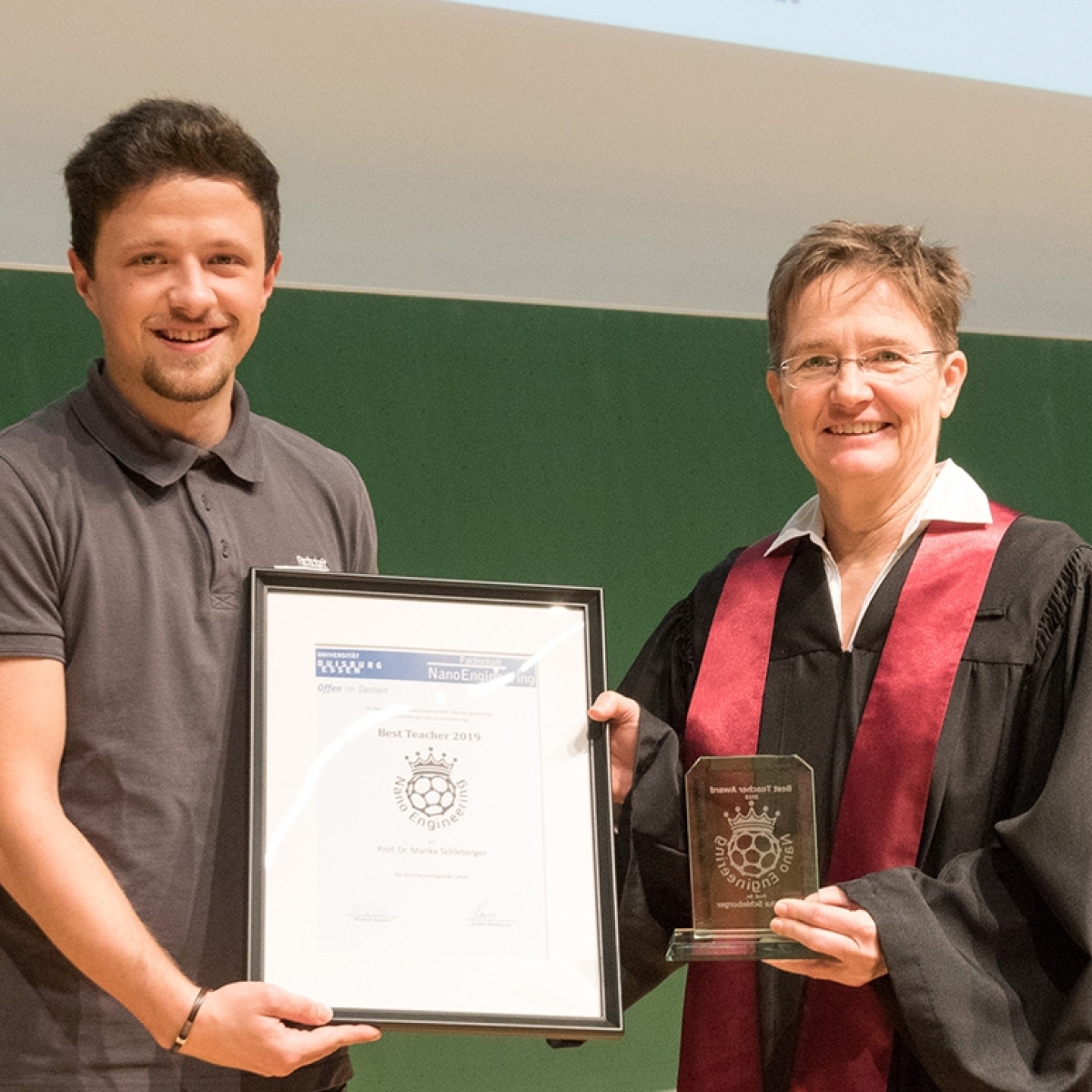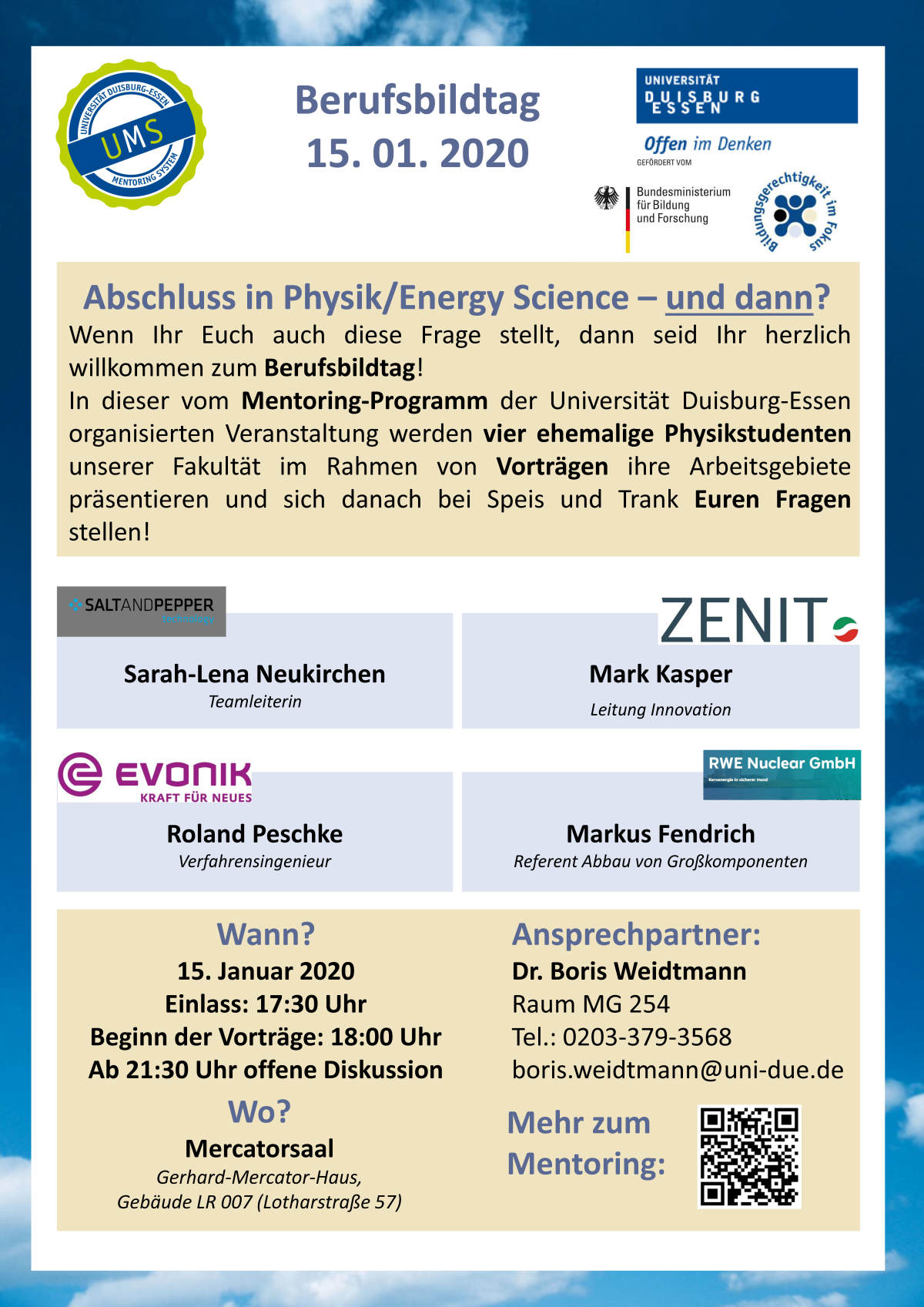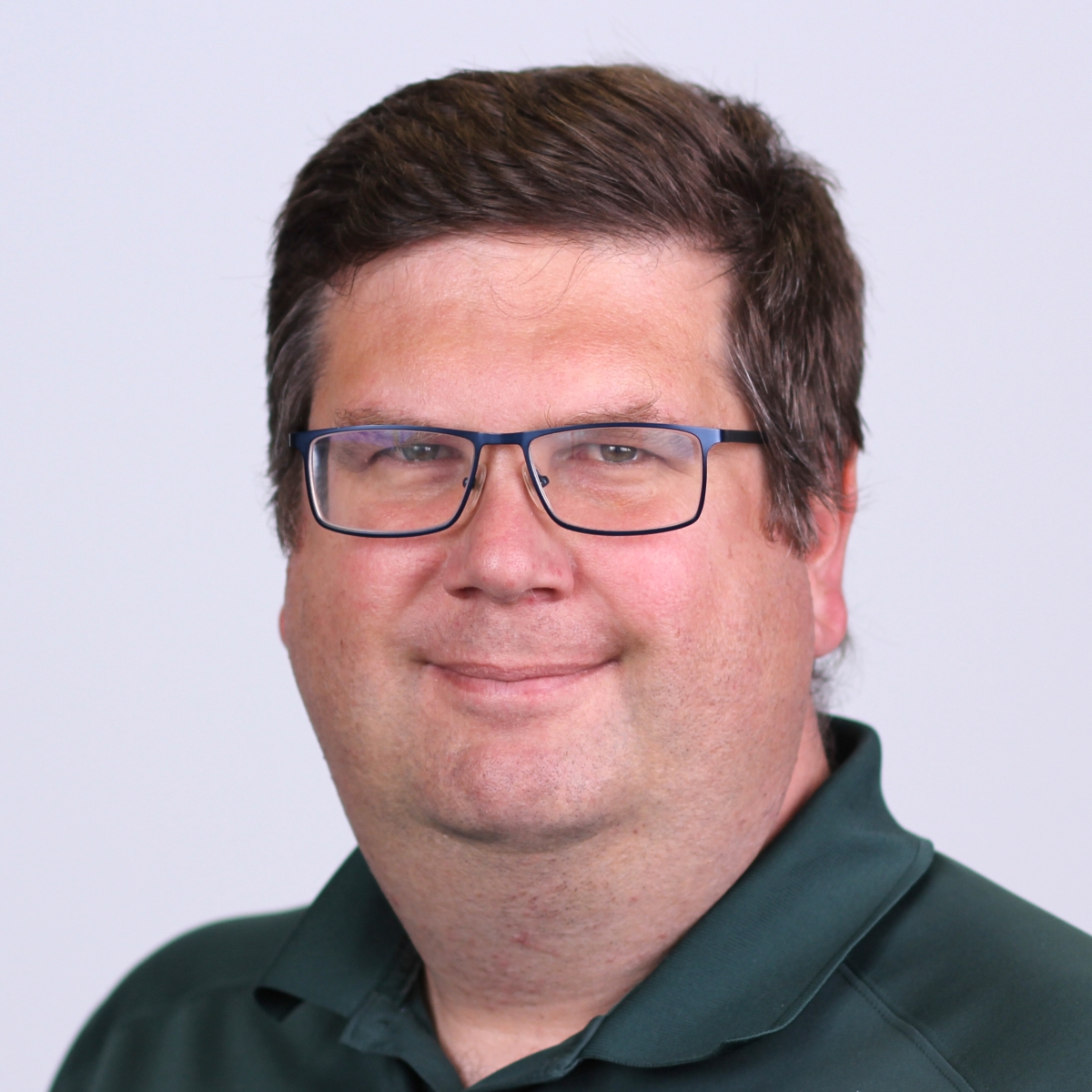News archive 2020
17.12.2020Research results result in patent
On December 16, 2020, a patent was published that had been filed by Prof. Dr. Rossitza Pentcheva and Dr. Benjamin Geisler from our Faculty of Physics. The European Patent Office has decided to grant the European patent EP 3580788 Thermoelectric element, thermoelectric generator, Peltier element and method of manufacturing a thermoelectric element on Nov. 19, 2020. It is based on results published in 2017 in the journal Physical Review.
16.12.2020Research team builds extremely precise pressure sensor based on graphene
Ultra-thin materials are booming. While they caused a sensation shortly after their discovery, especially in the fundamental sciences, the layers, which are only a few atomic layers thick, are increasingly becoming the focus of application-oriented research, as their optical, electronic and mechanical properties enable novel applications. The European Union recognized this potential early on and launched the Graphene Flagship in 2013, which is also increasingly targeting applications in its second phase. Within the Flagship, a collaboration of researchers from TU Delft (AG Steeneken), Université Basse Normandie and AG Schleberger (UDE) has now succeeded in building a graphene-based pressure sensor that allows gases to be detected with the highest precision. Graphene is a single layer of carbon with a thickness of less than one nanometer, which in this case is equipped with a well-defined pore and seals off a small gas reservoir. The special feature of the sensor is that detection is not based on chemical reactions, but on the permeation time of gases through the porous graphene membrane, which acts as both a gas pump and a pressure sensor. The idea is simple: light gases are faster and thus escape from the reservoir sealed by the membrane more quickly than heavy gases. The advantages compared to conventional sensors are manifold: the sensor presented is extremely small (see Fig.), fast, energy-saving and yet very sensitive.
As simple as the principle may sound at first, the art lies in manufacturing the heart of the sensor, the porous graphene membrane, and determining the permeation rates with sufficient accuracy. The Schleberger group has been working for some time on the production of self-supporting 2D materials for use in ultrafiltration in the FLAG-ERA project NU-TEGRAM, but also as a target material for the generation of ultrashort ion pulses in SFB 1242. After the idea was born, the first sensors were perforated with ions at the heavy ion accelerator GANIL in France, since the Schleberger group and colleagues there had already gained extensive experience with the perforation of graphene and other 2D materials. In the final stage, the pores were created with a focused ion beam, which again facilitated the fabrication and measurement by the Delft colleagues. Measurements on the function and efficiency of the gas sensors were carried out at TU Delft (AG Steeneken) and prove that the sensor works perfectly (see figure).
The results of this successful collaboration have now been published in Nature Communications:
I. E. Rosłoń, R. J. Dolleman, H. Licona, M. Lee, M. Šiškins, H. Lebius, L. Madauß, M. Schleberger, F. Alijani, H. S. J. van der Zant & P. G. Steeneken, High-frequency gas effusion through nanopores in suspended graphene, Nature Communications 11 (2020) 6025
More Information: Prof. Dr. Marika Schleberger, Experimental Physics, Tel. 0203/37 9-1600, marika.schleberger@uni-due.de
15.12.2020New Video from Theoretical Physics
After several videos from experimental physics there is now also a video from theoretical physics. Whoever thought that exciting physics can only be presented by complex apparatuses will be disabused. Five physicists from the König and Sothmann groups make no secret of their enthusiasm for theoretical physics.
14.12.2020Video trailer of the Faculty of Physics
Just in time for the pre-Christmas season, the video trailer of the Faculty of Physics is online.
Its unusual concept - parallel running 3 x 3 single videos are shown - shall indicate how broad the spectrum of science is in our faculty. Of course, only a tiny part of the numerous topics on which we do intensive research in parallel is shown. In the future, new excerpts from currently shot videos will be used again and again.
As befits a trailer, it only shows excerpts from videos that have so far been shot at our institute - more can be seen here:
09.12.2020New professor in our faculty: Juniorprofessor Dr. Manuel Gruber
As of December 1, 2020, Dr. Manuel Gruber has been appointed as Juniorprofessor for "Imaging of Condensed Matter in the Time Domain" at our Faculty of Physics. This is a junior professorship within the framework of the Tenure Track Program for the Promotion of Young Scientists (WISNA), which is funded by the German Federal Ministry of Education and Research.
In his previous position at the Christian-Albrechts-University of Kiel, Mr. Gruber has headed a subgroup which is doing research on "Molecular Magnetism" in the research group of Prof. Dr. Richard Berndt.
Gruber was born in Strasbourg, where he also completed his Bachelor and Master studies. In a cotutelle procedure he was awarded a doctorate by the University of Strasbourg and the Karlsruhe Institute of Technology for his research, which he conducted at both universities.
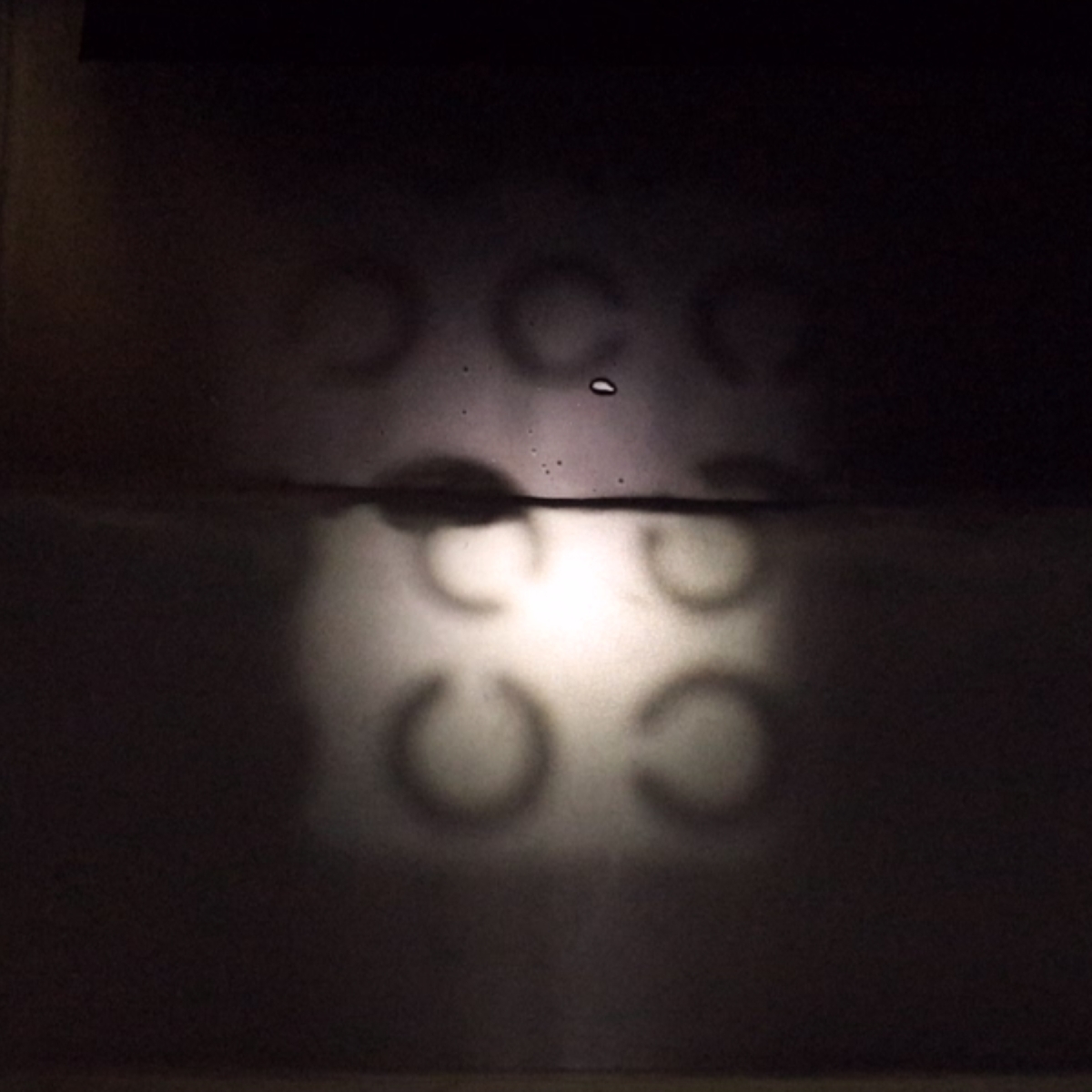
08.12.2020Puzzles in Advent
Some of you may have already noticed: in this Advent, every Advent Sunday, a little physical puzzle is presented on the social media channels of the faculty. These puzzles are mainly aimed at physics enthusiasts to show how fascinating physics can be, but of course everybody is welcome to do puzzles and toss around. The next puzzle will be on the upcoming 3rd Advent on the topic of electrodynamics.
Have fun with the puzzle!
07.12.2020Energy Science Colloquium "Energy Systems in Comparison"
The colloquium "Energy systems in comparison" started on 11 November 2020. In this series, experts from research and industry give exciting lectures on the subject of energy. On December 8, for example, there will be a lecture by Prof. Rehtanz on the topic of "Electric power networks as the basis for a sustainable energy supply".
https://uni-due.zoom.us/j/91564627937?pwd=bDUwK3dOVUZRdVgwSXROelErYXV3UT09
Meeting-ID:91564627937
Kenncode: 591931
01.12.2020New project in the zdi student lab - Energy for the future
Many young people get involved with "Fridays For Future" and take to the streets to help protect the climate. In order to strengthen their interest in natural sciences and appropriate courses of study, the zdi student laboratory at the University of Duisburg-Essen (UDE) is launching the "Energy For Future" project.
Anyone fighting against climate change and for renewable energy supplies cannot avoid scientific facts and forecasts. To understand and interpret them, you need the natural sciences. The zdi student laboratory promotes courses of study such as physics and engineering sciences, especially nanoengineering and energy science. "This commitment can be used to get young people excited about MINT professions in which they can then actively participate in climate protection themselves," says director Dr. Kirsten Dunkhorst.
Courses are being developed on the subject of "Intelligent Materials for Energy and the Environment", which will use experimental offerings such as MINT boxes, but will also involve partners from regional small and medium-sized businesses. A great deal of knowledge comes from the UDE profile focus on nanosciences and the Center for Nanointegration Duisburg-Essen (CENIDE). With the support of the city, the Stadtwerke Duisburg could also be won as a partner, which pleases city director Martin Murrack: "The project shows once again how the enormous potential of the University of Duisburg-Essen can be used profitably for both sides".
The zdi student laboratory has taken precautions to ensure that the offers are available at all times in the future. "We are also setting up an e-learning platform containing background information, explanations on how to use the boxes, didactically prepared material and further links," says Dunkhorst. The digital extension of the MINT boxes can be used for home schooling or digital teaching, for example.
For the new project, the North Rhine-Westphalian Ministry of Economic Affairs is providing funding of almost 48,000 euros from the European Regional Development Fund (ERDF) as part of the state initiative zdi. The project is co-financed with funds from the school lab "Insights into the Nanoworld".
Further information:
Dr. Kirsten Dunkhorst, zdi student laboratory, phone 0203/37 9-3409 or 9-8030, kirsten.dunkhorst@uni-due.de
Editor: Cathrin Becker, Tel. 0203/37 9-1488, cathrin.becker@uni-due.de
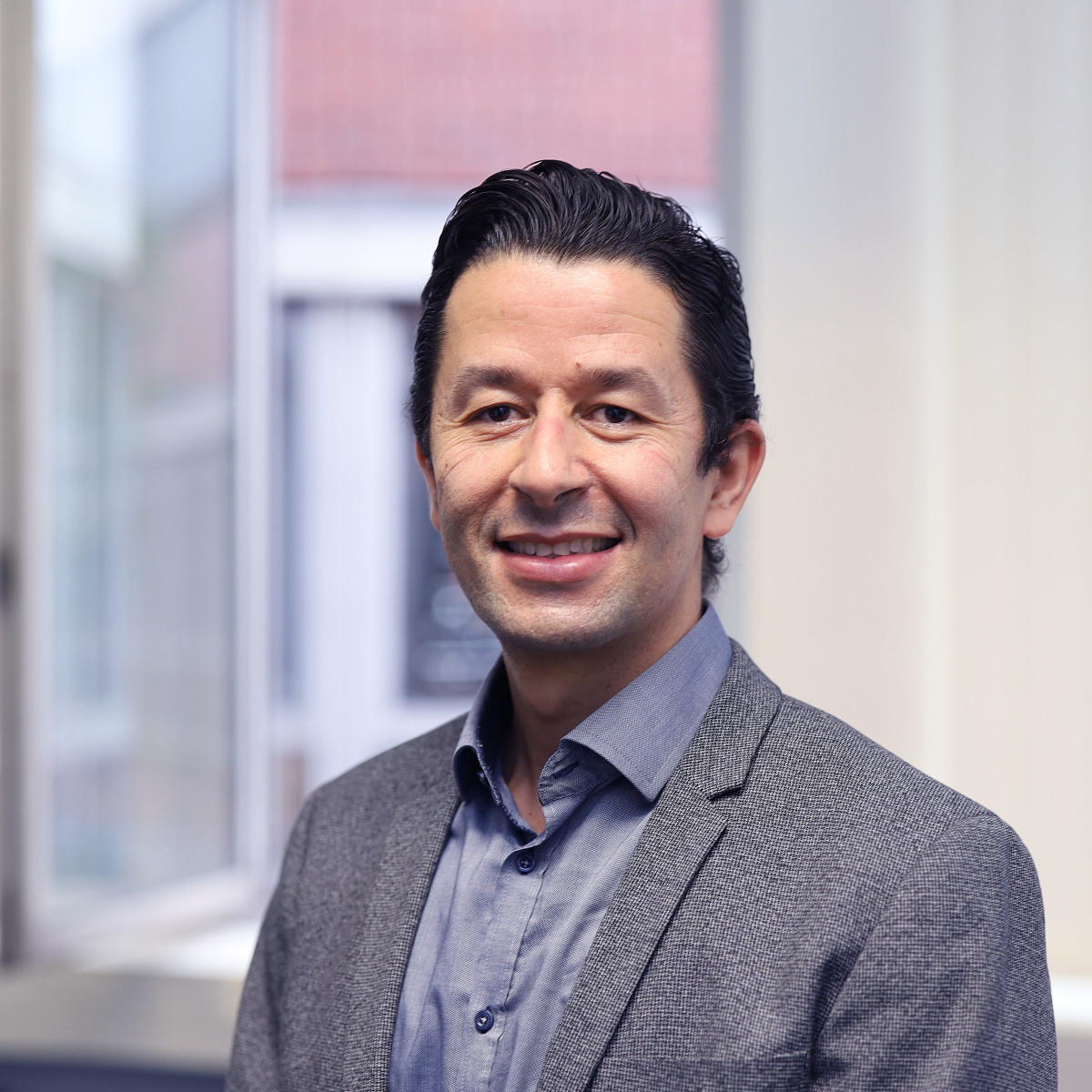
24.11.2020New professor in our faculty: Prof. Dr. Samir Lounis
On November 12, the Dean welcomed a new professor in our Faculty of Physics: Prof. Dr. Samir Lounis. Appointed according to the "Jülich model", Mr. Lounis is employed at Forschungszentrum Jülich, but will carry out his duties as professor at the University of Duisburg-Essen. Since 2015 he has held a junior professorship at RWTH Aachen University. At Forschungszentrum Jülich, he heads a group of young scientists who conduct research on the topic "Functional Nanoscale Structure Probe and Simulation Laboratory" at the Peter Grünberg Institute.
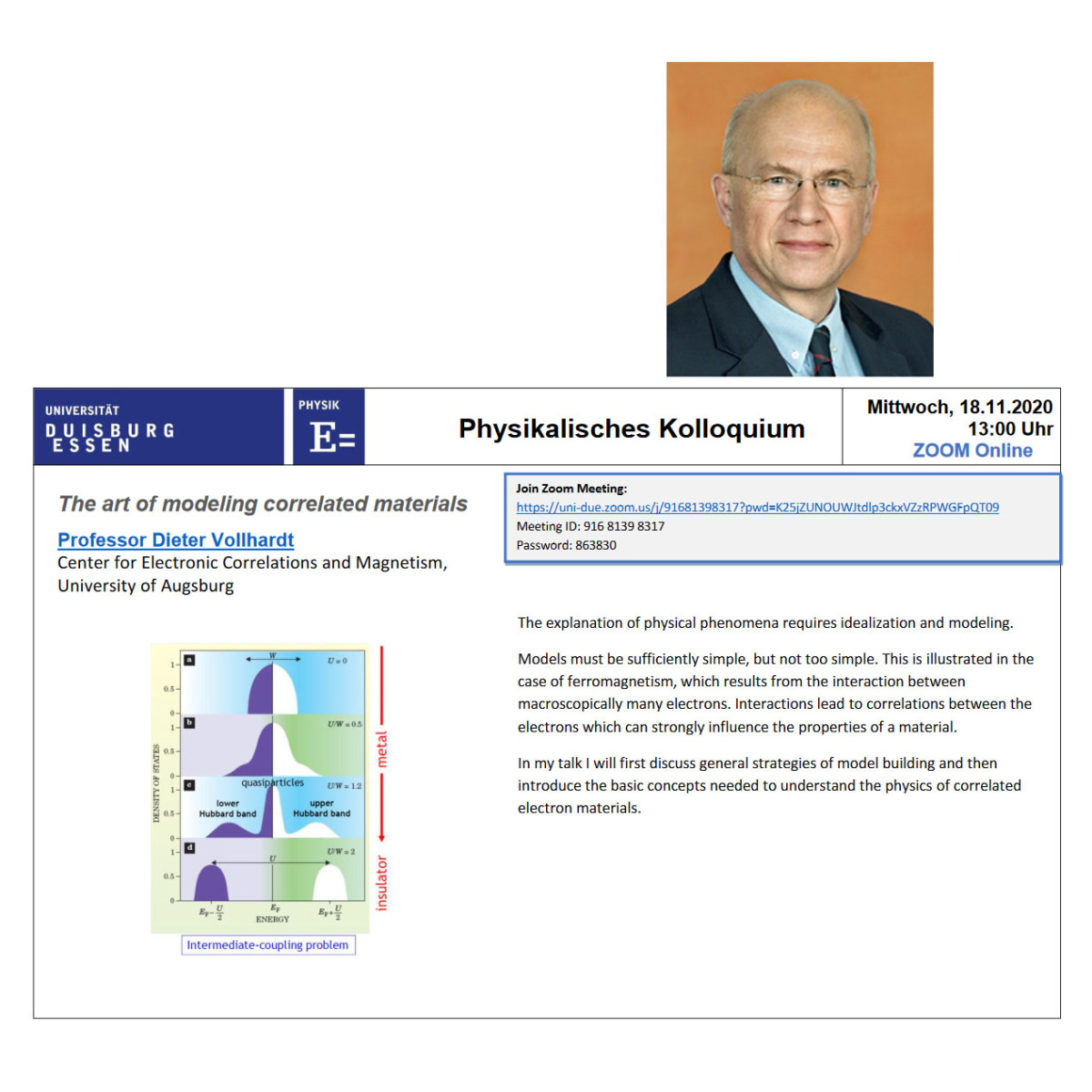
19.11.2020Physics Colloquium successfully started into the winter semester
The Physics Colloquium of the Faculty has started the winter semester very successfully. Prof. Dr. Dieter Vollhardt, a very renowned physicist from the field of theoretical physics, started the series of lectures. In 2010 Vollhardt was awarded the Max Planck Medal, the highest distinction of the German Physical Society for achievements in theoretical physics.
More than 75 participants enjoyed an excellent zoom lecture on "The art of modeling correlated materials". Next Wednesday, November 25, 2020, we will welcome Prof. Samir Lounis to his inaugural lecture with the topic "Spin-orbitronics in the nanoworld " in our colloquium.
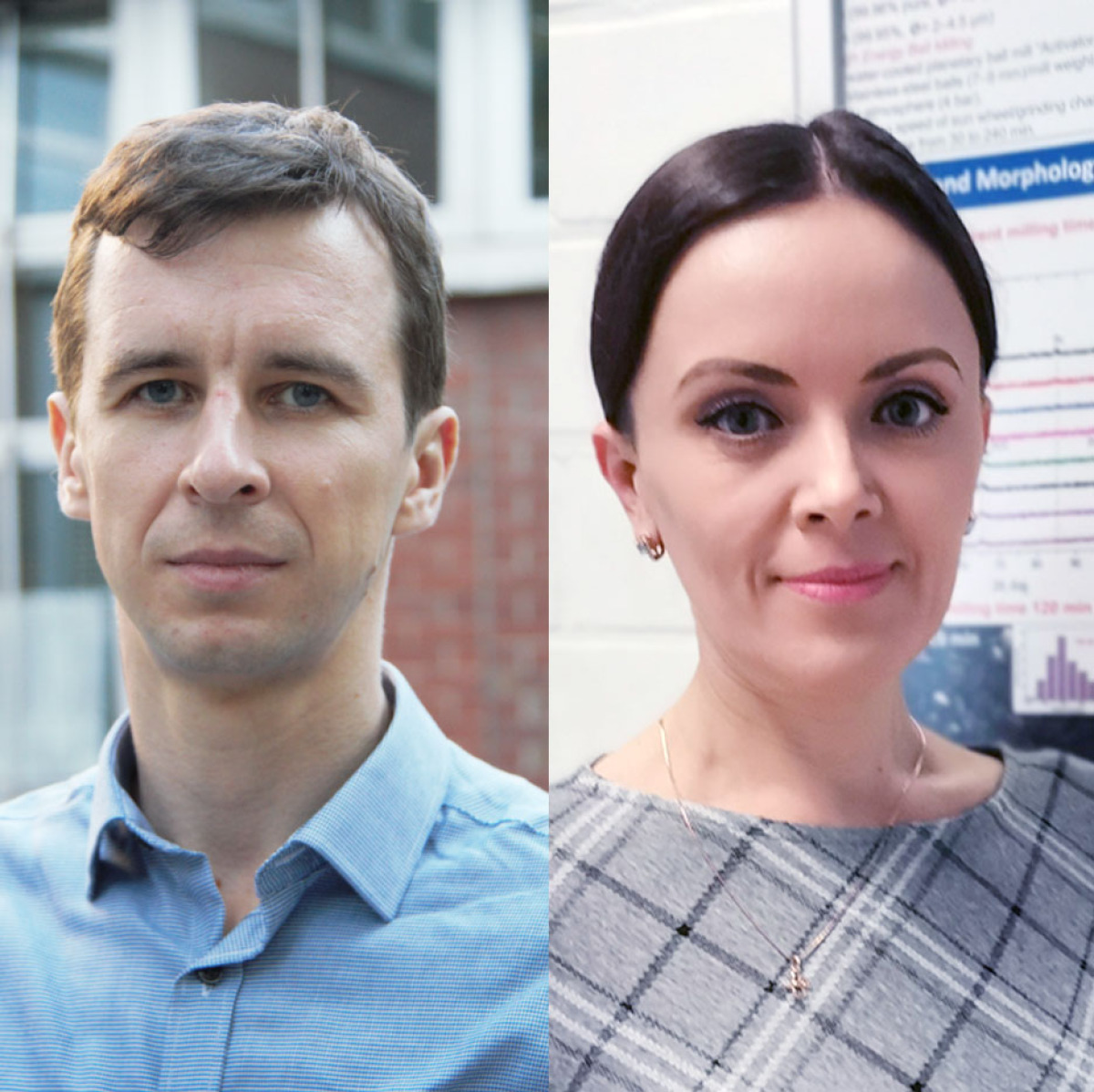
05.11.2020DAAD scholarships financed research stay
The research group of Prof. Dr. Michael Farle welcomes Dr. Natalia Shkodich (Merzhanov Institute of Structural Macrokinetics and Materials Science, Russian Academy of Sciences) and Dr. Mikhail Cherkasskii (Saint Petersburg State University) who recently joined us for a 3 months research stay funded by DAAD scholarships (“Research stays for University Academics and Scientists, 2020and “Dmitrij Mendeleev” Programs).
Dr. Natalia Shkodich is an expert on combining High-Energy Ball Milling (HEBM) and Spark Plasma Sintering (SPS) to produce nanostructured and amorphous materials from immiscible metals (so-called pseudo alloys), metallic glasses, and high-entropy alloys (HEAs). She aims at producing novel nanostructured CoCrFeNiGa magnetic high entropy alloy (Mag HEA) particles and volume MagHEA materials with a large magnetization, high Curie temperature and tuneable coercivity as well as excellent mechanical properties.
Interests of Assoc. Prof. Dr. Mikhail Cherkasskii are focused on the understanding of magnetization nutation in ferromagnets and its coupling to precession and ferromagnetic resonance. He is working on the development of an analytical approach to describe inertial spin dynamics, nutation resonance and collective excitations in ferromagnets.
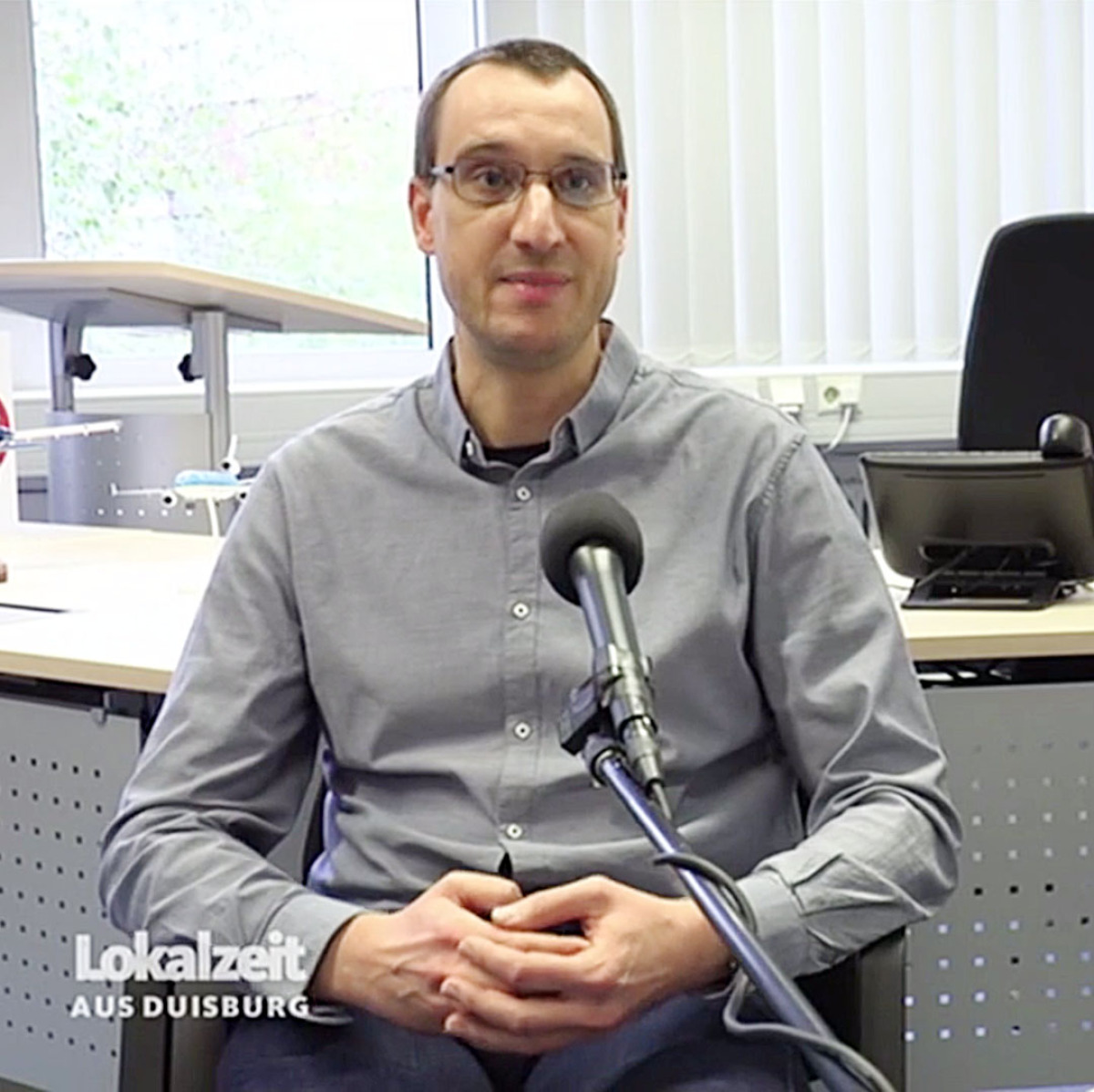
04.11.2020To be continued - WDR Lokalzeit again in our faculty
To be continued - after a few days, the radio editor Mrs. Sürgit came to us again to shoot a WDR-Lokallzeit report about the start of the semester in the Faculty of Physics. This time she was especially interested in the Buddy System. Florian Mazur, who developed the concept together with Anne-Kristin Pusch and successfully implemented it, was available to answer her questions. Lisa Danzig gave insights into the completely changed situation in the student council work. Jana Filatova, a new freshman in the physics department, dared to report from her perspective.
02.11.2020Anna Grünebohm wins NRW innovation award
ICAMS junior professor Anna Grünebohm, was awarded the Innovation Prize of the State of North Rhine-Westphalia in the young talent category.
Her research focuses on ferroelectric materials, which are able to cool themselves down under certain conditions or to generate electricity from movement. Her cross-scale computer simulations contribute to a fundamental understanding of the interaction between a material, its microstructure and its functional properties.
The prize is endowed with 50,000 euros.

19.10.2020WDR Lokalzeit in the Faculty of Physics - hybrid semester in attendance and online: How does it work?
WDR-Lokalzeit Duisburg was a guest in our Faculty of Physics and reports on the upcoming "Hybrid Semester in Presence and online".
20.10.2020Heisenberg-Fellows in Physics and Mathematics - Investigating dust
It is more than just dirt: dust influences the weather, the water cycle and the chemical composition of the atmosphere. Dr. Eric J. R. Parteli at the UDE is investigating how it moves and its ablation changes the earth's surface. For his outstanding project, he has been included in the prestigious Heisenberg Program of the German Research Foundation (DFG). At the same time, UDE mathematician Dr. Andreas Nickel is pleased about the extension of his Heisenberg fellowship.
Eric Parteli comes from University of Cologne, where he studied, among other topics, the influence of deserts on climate. At the UDE Faculty of Physics he is investigating in his Heisenberg project “Multiscale Simulation of Earth Surface” how sand und dust are distributed in and influence the environment and atmosphere.
The emission of dust is poorly understood in physical terms yet; today's climate models rely on empirical evidence. One thing is clear: “Dust and sand are not mainly carried away by the wind, but by the jump-like transport of the sand particles (saltation)“, says Eric Parteli and explains: “The wind accelerates them, they move through almost ballistic trajectories. When they hit the ground, new sand and dust particles are ejected.“
At UDE, he will calculate for example the flight paths and interactions of flying particles with each other. This is indispensable for reliably predicting the emission rates of dust, he says. And to be able to quantitatively describe the interaction between soil, climate and ecosystem. “With my approach, I can strengthen the research on the physics of granular matter and environmental physics at UDE“, he says happily. Thus he will make important contributions to the topic of planet formation, which is also being investigated experimentally at the Faculty of Physics.
At the same time, the theoretical physicist wants to analyse, how the appearance of the earth changes when dust, sand and earth are removed from its surface and landscapes erode. Future climate models and weather forecasts would have to take this into account.
At the UDE Seminar for Algebraic Geometry and Number Theory, Privatdozent Dr. Andreas Nickel works less geophysically. As a Heisenberg fellow, the basic mathematical researcher has been working on invariants in number theory for quite some time. His funding will be extended by two years.
The Heisenberg Programme honours highly qualified researchers in all disciplines who already meet the requirements for a permanent professorship. It should also enable them to work on advanced topics for five years.
Further information:
Dr. rer. nat. Eric J. R. Parteli, Theoretical Physics, Heisenberg group, eric.parteli@uni-due.de
Editor: Alexandra Nießen, +49 (0)203/37 9-1487, alexandra.niessen@uni-due.de
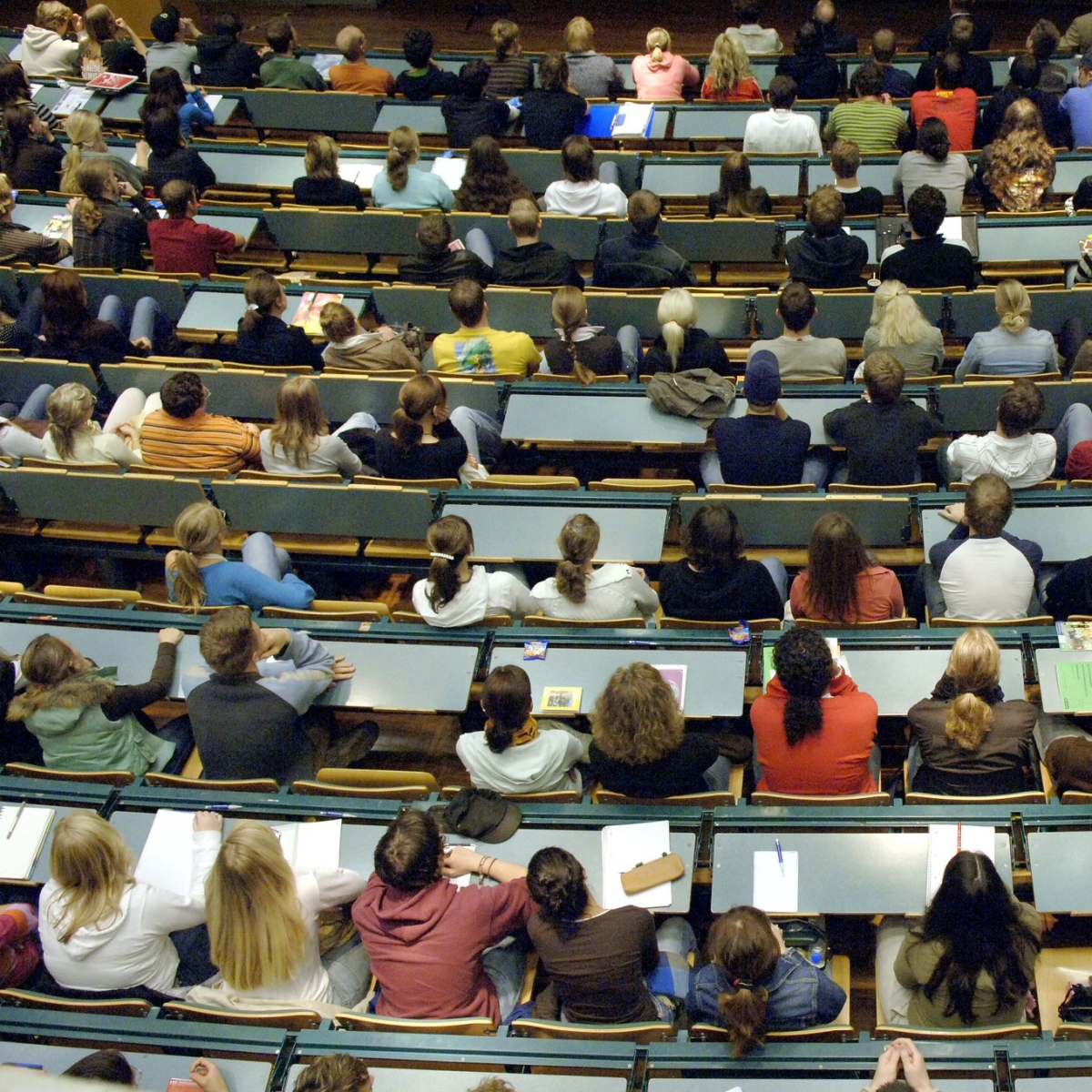
13.10.2020Introductory event for Master students
Thursday, October 22rd 2020, 10-12 am
At the beginning of the Master's program, a consultation on the choice of subjects and the structure of the research phase should be completed (examination regulations § 1, paragraph 9).
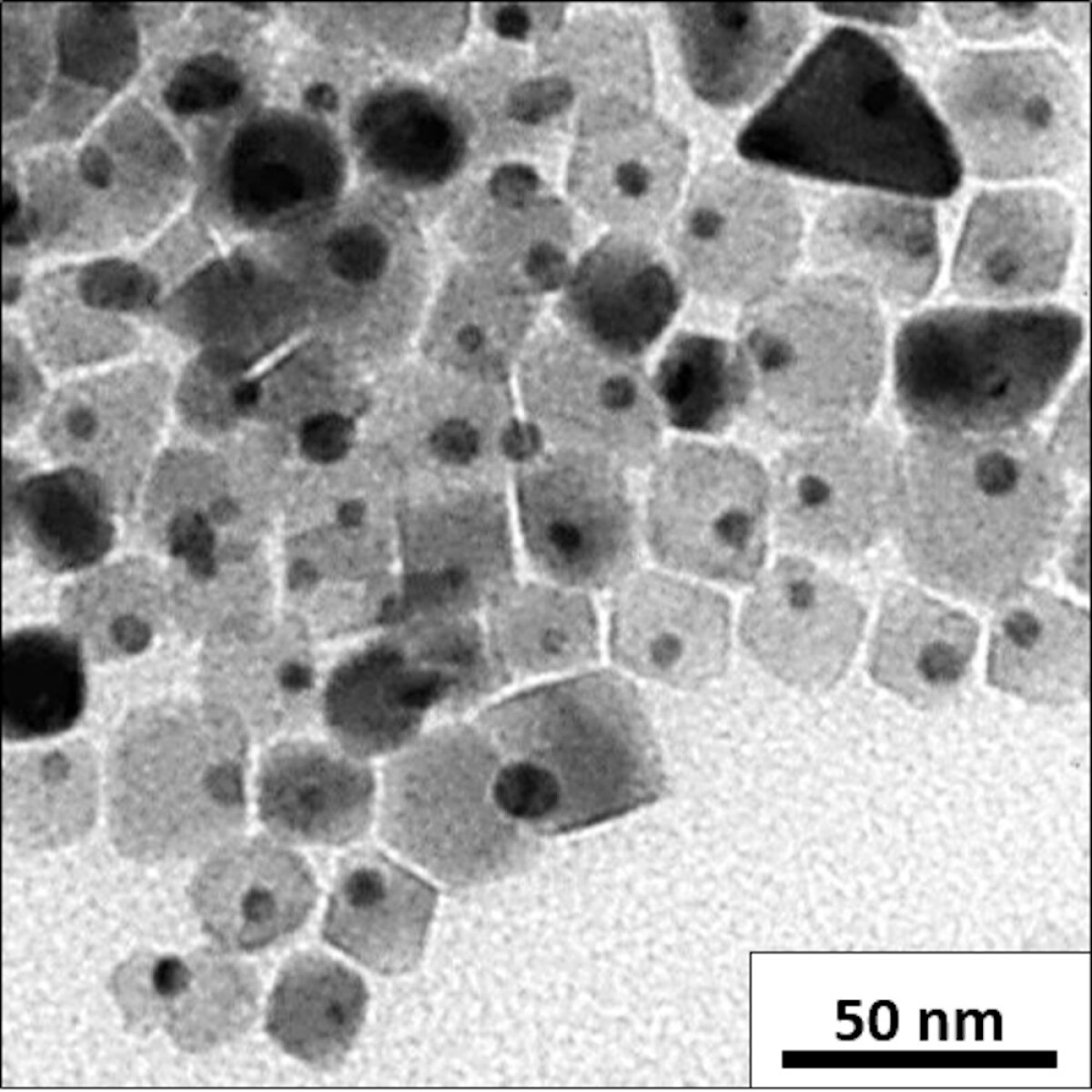
15.09.2020Award for German-Russian Cooperation - Tailor-made Tiny Tots against Cancer
Their nanoparticles of gold and magnetite have been specially developed for the diagnosis and therapy of tumors: Physicists from the Center for Nanointegration (CENIDE) at the University of Duisburg-Essen (UDE) and Moscow colleagues will be honored for their successful collaboration on September 15th.
"Theranostics" is a portmanteau word combining "therapy" and "diagnostics" and is of crucial importance in medicine: In the project that has now received the award, it refers to the potential applications of the particles, which are only 25 nanometers in size and are injected into affected body regions of patients. Using computer tomography or magnetic resonance imaging, tumor tissue can thus be detected and then targeted in the next step - with the same particles. The combination of precious metal and mineral offers several possibilities; for example, magnetite can be heated by an alternating magnetic field. In doing so, it heats up so strongly that it destroys the surrounding tumor. Healthy tissue remains unharmed and the biocompatible particles are later broken down by the body.
"In contrast to particles that are already commercially available, our particles are optimized for precisely this benefit," says UDE physicist Priv.-Doz. Dr. Ulf Wiedwald. Now the cooperation between him and his colleague Prof. Dr. Maxim Abakumov from the Russian National University of Science and Technology MISiS is being honored in the category "top-level research".
The cooperation started with Wiedwald's guest professorship in Moscow in 2017/18. "Since then, we have jointly published four papers in renowned journals in the short time available," says the physicist.
The award is presented within the "German-Russian Year of University Cooperation and Science 2018-2020", which is organized by the German Academic Exchange Service (DAAD) and the National University of Science and Technology.
Image: Electron microscopic image of magnetite-gold nanoparticles for theranostics. © Beilstein J. Nanotechnol. 2018, 9, 2684-2699
Further information:
private lecturer Dr. Ulf Wiedwald, experimental physics, Tel. 0203/37 9-2633, ulf.wiedwald@uni-due.de
Editor: Birte Vierjahn, Tel. 0203/37 9-8176, birte.vierjahn@uni-due.de
21.08.2020For a successful start at the university - Ask Buddy!
The first day at university? For many it is getting closer, and there is still so much to ask. Here comes a buddy right on cue - someone who has already completed a few semesters and knows how things are going. In Social Sciences, eight students are now there for the newcomers, initially in video chat and other online formats. The physics buddy system has been running since June. Here one has the beginners in view as well, but also wants to attract interested students to study, "and that", says Dr. Florian Mazur, "we are also successful".
It is easier to ask questions in a relaxed atmosphere, among almost peers whose university start was not so long ago. 11 physics buddies can be holed up in video chats, whether it's about the subjects, their experiences during their studies or student life. The chats take place several times a week on fixed dates, there is no need to register. "In addition to informal counseling, we also want future students to get to know each other," Dr. Mazur explains the concept.
Two of these temporary buddies are Charleen Lintz and Kevin Vomschee. She studies Energy Science, he physics; both are in their fifth semester. What those interested want to know is very different, they say: "Many ask when you're allowed to go to the lab for the first time, while others are uncertain whether it's even possible to study in time," says Charleen. "I can then take away their fear right away!"
The way studies are conducted in the times of Corona is also a topic, she says: "Some are afraid that they will hardly get to know their fellow students when a lot of things are going on online. We try to counteract this before the beginning of the course - for example with our chats!
Kevin Vomschee adds: "I can only encourage everyone to simply approach others. It is much easier to study together and you can make friends for life.
Ask Buddy! - This also applies from the orientation week on. Each faculty has various measures to ensure that freshmen settle in quickly. In addition, the program of the International Office provides foreign students with mentors who also help with forms and authorities. Dr. Florian Mazur emphasizes: "We in the Physics Department ensure intensive personal support for everyone in the first year of study. And also later on, no one is left alone with their questions. After all, studying at the UDE should be fun until graduation!
Further information:
First semester portal: https://www.uni-due.de/erstsemester
Buddy System Physics: https://www.uni-due.de/physik/buddy
Buddy Program Social Sciences: https://www.uni-due.de/gesellschaftswissenschaften/studienstart/buddys
Buddy Program International Office: https://tsc-due.org/buddy-programm
Editor: Ulrike Bohnsack, Tel. 0203/37 9-2429, ulrike.bohnsack@uni-due.de
19.08.2020Students take off - Excursion to the airport Dinslaken Schwarze Heide
An excursion under special conditions took place on August 11th, 2020. Due to the Covid-19 pandemic, the excursion could only take place in small groups and with masks instead of a large group, as in previous semesters. With temperatures above 30 degrees Celsius, this was a great challenge, but everyone coped well.
The excursion was offered to the students of the physics teacher training program, who had heard the lecture "Physics around flying" in the last semester. The first item on the program was a guided tour of the Dinslaken Schwarze Heide commercial airfield. Afterwards, the students had the opportunity to experience at close quarters during a half-hour flight the forces involved in flying, how to control an aircraft and how general air traffic is organized. The students also took home many new impressions of the Ruhr region from the air and were amazed at how green the Ruhr region is from "above". The pilot was Dr. Florian Mazur, who also gave the lecture and was thus able to follow up first-hand on what was learned in the lecture.
Another special highlight on this day was the professional photo shootings of an aircraft for aerobatics from the Extra Aircraft, which took place at the commercial airfield on this day. The aircraft flew only a few meters over the runway, sometimes in a supine position. Of course, such a flight maneuver cannot be performed with a conventional aircraft, but only with specially designed machines.
Despite the successful exclusion, it is to be hoped that the situation with regard to the pandemic will soon ease again and thus larger excursions with fewer restrictions will again be possible. Despite Corona, this year's excursion was again very well received. It shows that practice should always complement theory in order to make physical relationships more understandable and thus make physics "tangible".
More pictures of the excursion can be found on the Facebook page of the Faculty of Physics.
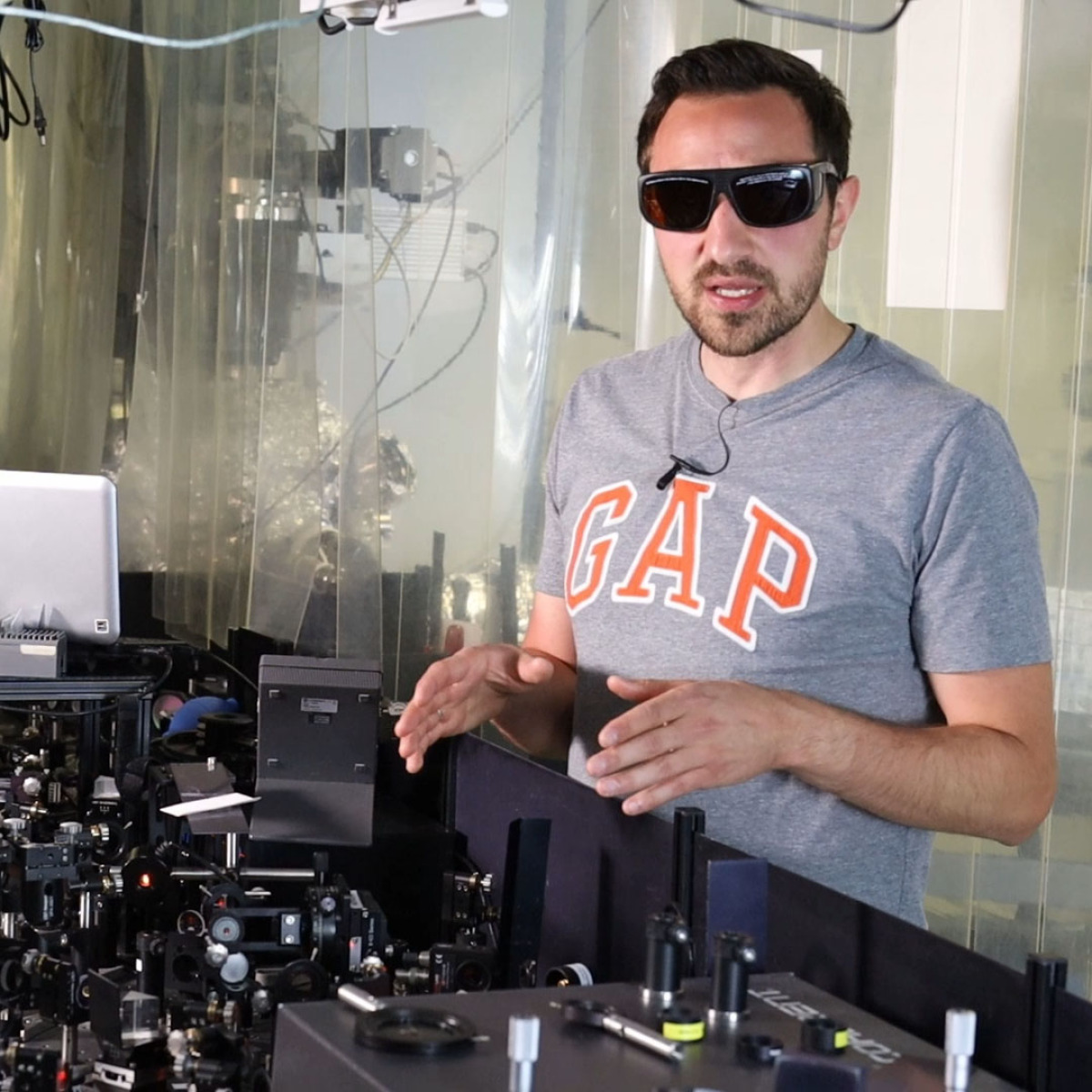
18.08.2020Video lab tour femtosecond laser laboratory
If you think that "femtosis" is a field of medicine, you will find completely new perspectives here. But even those who already know that this is a very short time frame will be presented with a lot of interesting information. So nothing like clicking! After a theoretical introduction to the topic by Prof. Dr. Uwe Bovensiepen, three other researchers will present the details of the sophisticated measuring apparatus.
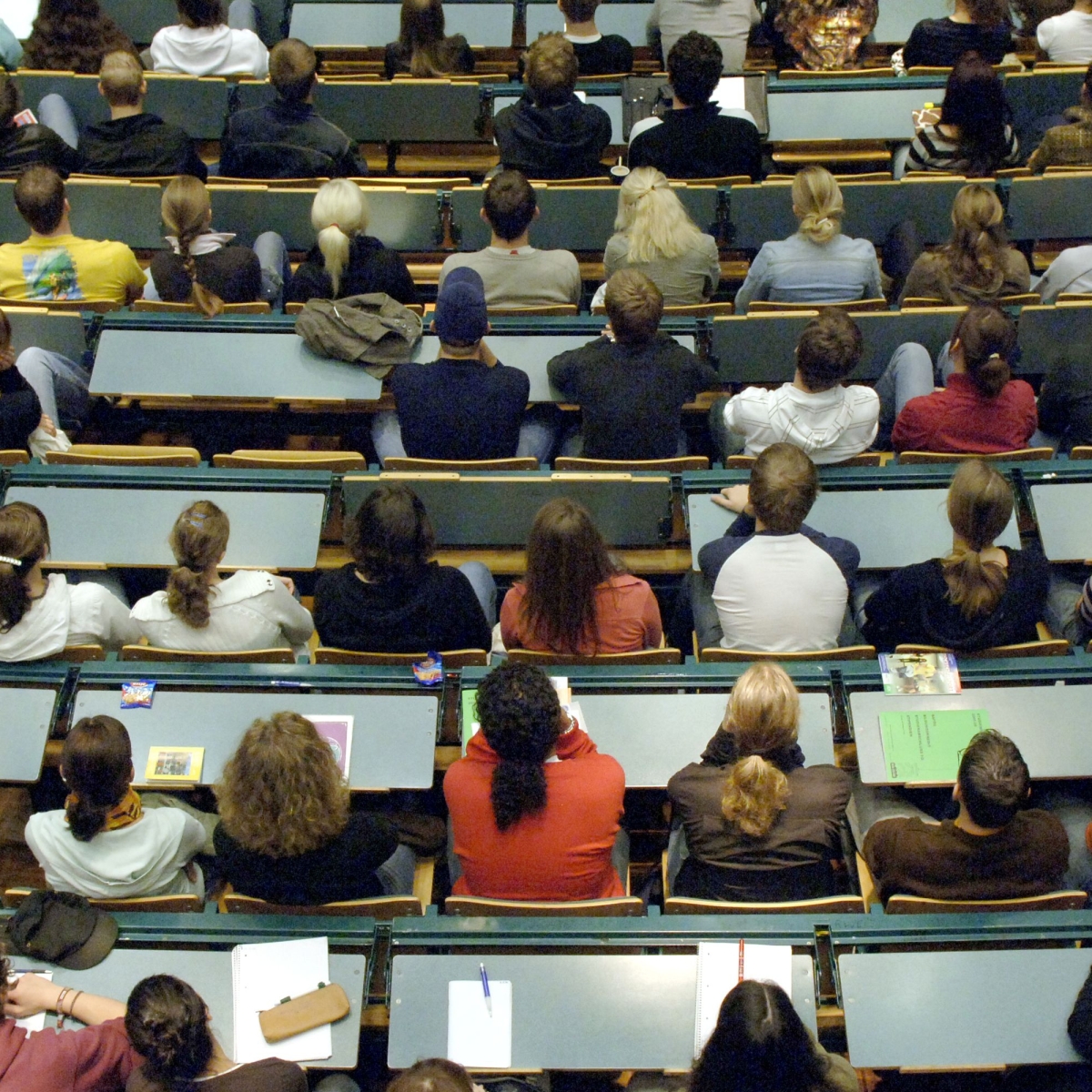
30.07.2020Registration break? - Not with us!
Dear prospective students,
You have probably already noticed that the official enrollment period at our university is taking a break between August 29 and November 1. However, this does not apply to the Physics, Energy Science and Teaching Physics programs. You can enroll with us throughout the year (i.e. also in September and October) - the processing only takes a few days longer than usual. Just fill out the form and send it to the address on the application form (Physics/Energy Science Campus Duisburg, Lehramt Physik Campus Essen).
Who do I ask if I get stuck somewhere?
Of course, our buddies will be happy to answer any questions that may arise or to forward you to the right contact person.
You can also contact us informally:
- Andreas Reichert (Physics)
- Anne-Kristin Pusch (Energy Science)
- Hendrik Härtig (Teaching post Physics)
We will gladly answer your questions!
How do I register for participation in the preliminary courses?
For the preliminary courses you can register for a mailing list here. You will then be automatically reminded of the possibility to register for the pre-course. From 01.09.2020, registration for the pre-courses will be done via an online form on the mintroduce website.
What happens if I register late for the course and what consequences does this have for my start of studies and the orientation week?
Fortunately none! When you enroll, you will receive an official student email address and also the opportunity to register on the Moodle learning platform for the individual courses of the winter semester. Through these portals you can also get a lot of information about the orientation week and all kinds of student activities. In this case just contact the buddies or the other persons mentioned and we will help you!
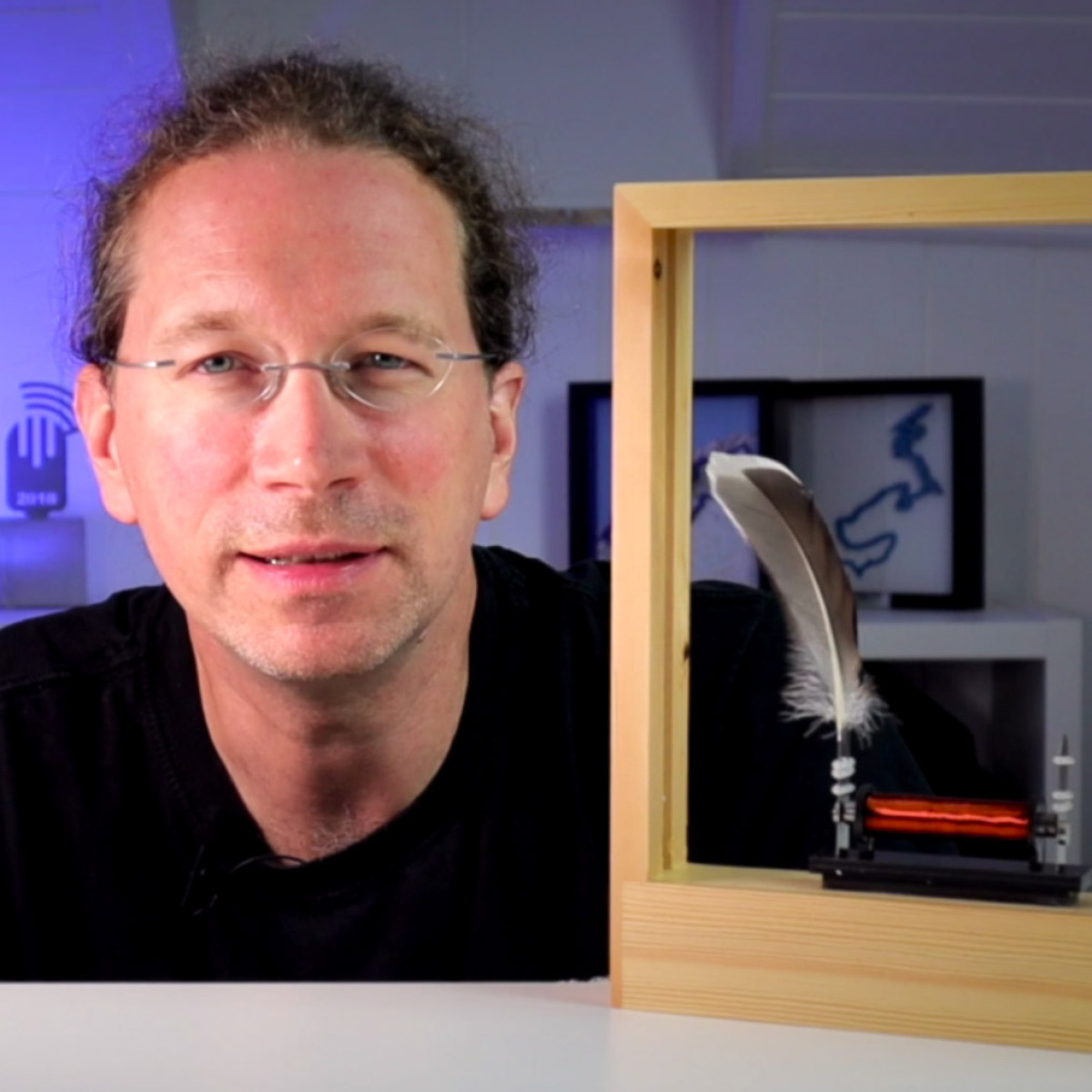
29.07.2020Zoom lecture: Enlightening facts about light: games, experiments and explanations
At this event everything revolves around light. But what is light actually? A ray? A wave? What are colors? And what makes light so special? It connects computers all over the world; it makes it possible to perform chemical analyses; and it gives us insights into the structure of atoms. Through experiments and explanations we want to pursue these questions. And in doing so, we want to get to know the many possibilities that light offers.
Date: Wednesday, August 5th 2020, 2-3:30 pm
Lecturer: Prof. Dr. Axel Lorke and Dr. Nicolas Wöhrl
27.07.2020New confocal Raman microscope in the work group of Marika Schleberger
For the characterization of 2D materials, the research group of Prof. Dr. Marika Schleberger has purchased a setup that allows spatially resolved Raman measurements in correlation with photoluminescence and scanning probe microscopy. The setup will soon not only be used by researchers in the group, but also in collaborations and by students in advanced practical training.
With a resolution of down to 500 nm, the different spectra can be recorded in parallel for each point and displayed in colour-coded form. "For a measurement with 250 x 250 points only about 15 minutes are required." reports Ms. Schleberger full of anticipation. "The new setup will greatly accelerate the work flow in the our group."
The students from physics, energy science and nanoengineering will soon be able to learn how to use the setup at an early stage and become familiar with the so-called 2D materials within the framework of the advanced practical training. Graphene is the best known representative of this material class, which is known for numerous outstanding effects and promises a broad spectrum of innovations. The discovery was awarded the Nobel Prize in Physics in 2010.
Unfortunately, it was not possible to pay for the large device out of petty cash due to the acquisition costs of approx. 470 000 €: The main part is borne by the DFG and the State of NRW and the University of Duisburg-Essen, respectively. In addition, the acquisition was supported by the Collaborative Research Centre SFB 1242, CENIDE and the Faculty of Physics.
Picture: Dr. Matthias Finger (WITec GmbH) and Prof. Dr. Marika Schleberger during installation
23.07.2020Info day for the study of physics, teaching physics and Energy Science on Monday, August 10th, 2020
During a web meeting on Monday, August 10th, 2020 at 10 a.m. and at 2 p.m., the physics degree program, the physics teaching degree program and the energy science degree program will be presented in three consecutive short lectures. Questions may be asked afterwards.
Please register for the Zoom meeting at 10 am.
More information about the physics program, the physics teaching program and the energy science program.
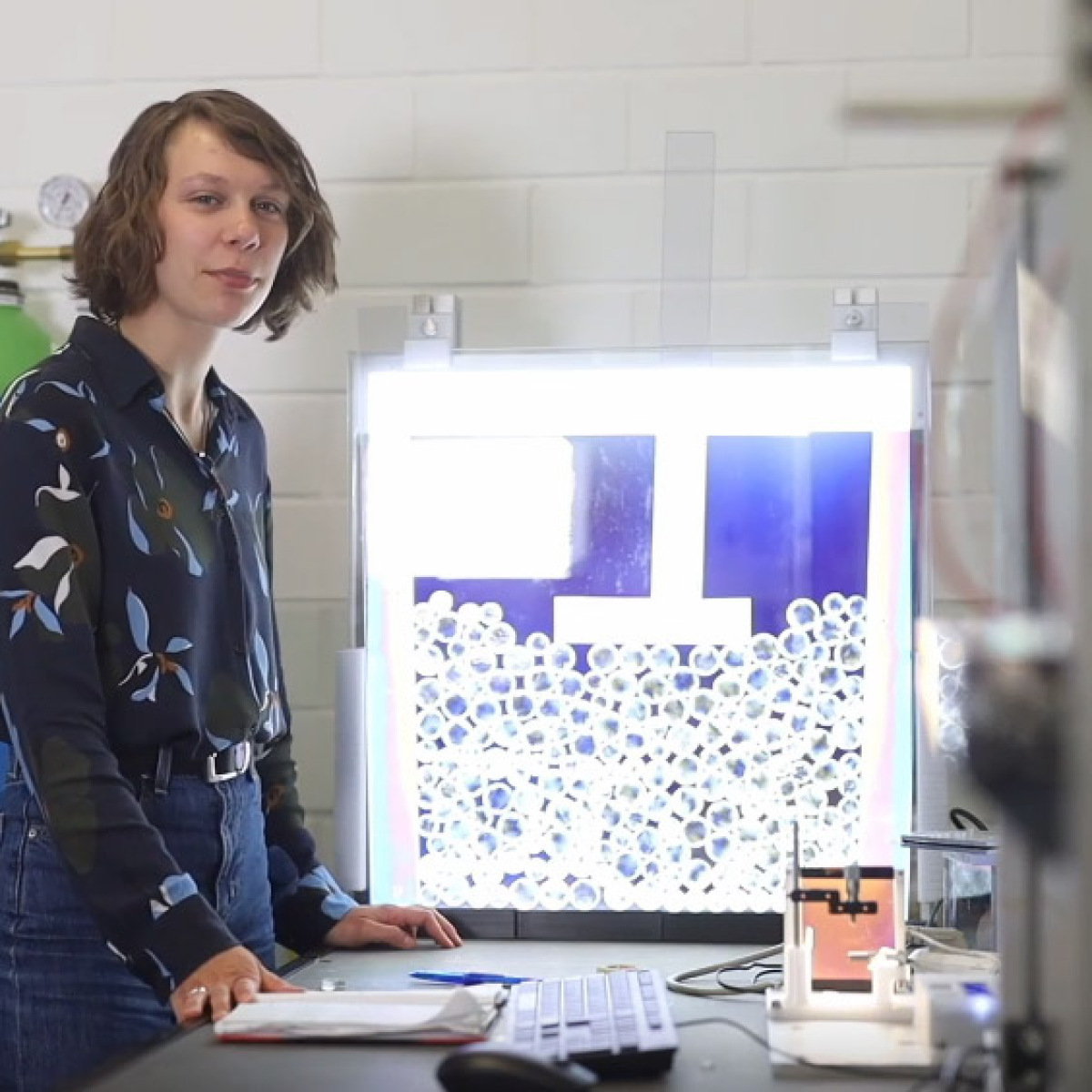
20.07.2020Video lab tour planet formation
In the research group of Prof. Dr. Gerhard Wurm, everything revolves around planets. How do they form? What are they made of? With experiments in the drop tower, during a parabolic flight, on board a balloon or even a space station, the members of the group try very successfully to answer these questions.
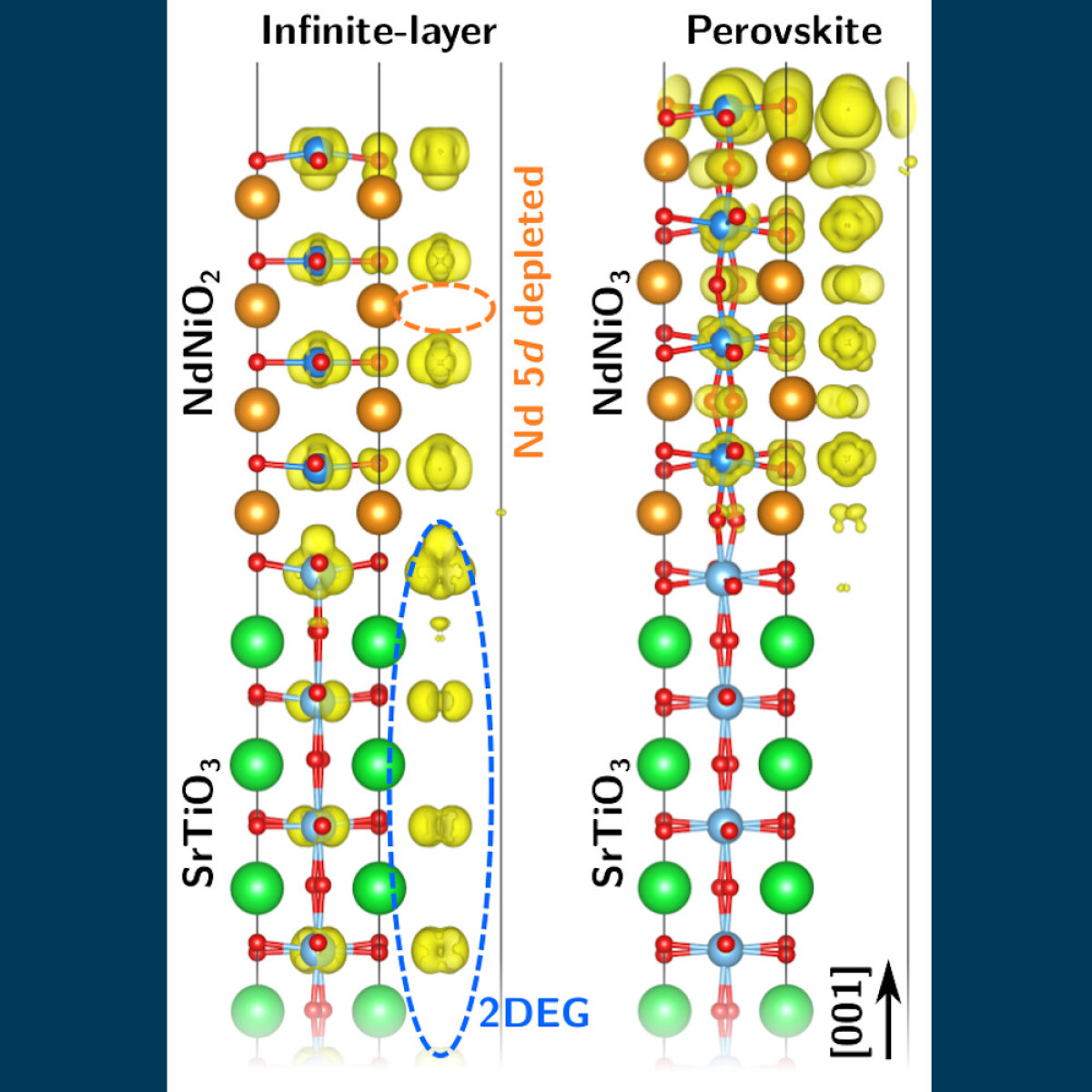
17.07.2020Superconducting nickelates - cuprate-like behavior in a nickel oxide film
Superconductors can transmit electricity over any distance without loss and play an important role in quantum computers and medicine. But the stars among electrical conductors usually only function at extremely low temperatures. Since the discovery of high-temperature superconductivity in 1986 in cuprates with their planar copper-oxygen plaques, scientists have been trying to realize similar behavior in other classes of materials. As recently as 2019, superconductivity was detected in a nickel oxide film, but what it was based on there is still unclear. Theoretical physicists from the Center for Nanointegration (CENIDE) at the University of Duisburg-Essen (UDE) have therefore studied the electronic properties of the material and found a possible explanation.
Since the bulk material of neodymium nickel oxide (NdNiO2), which has the same atomic structure and number of valence electrons as many cuprates, is not superconducting on its own, Prof. Rossitza Pentcheva and Dr. Benjamin Geisler focused on the role of film geometry: the system studied consists of a 1.5-nanometer-thick layer of the nickelate on a strontium titanate (SrTiO3) substrate.
2D electron gas discovered
The two CENIDE physicists simulated the properties of this so-called infinite-layer film compared to a perovskite film (NdNiO3) using quantum mechanical calculations on the MagnitUDE supercomputer. Although both systems exhibit a charge mismatch at the interface with SrTiO3, Pentcheva and Geisler found a key difference: only in the case of the infinite-layer film does this charge mismatch cause a two-dimensional electron gas to form at the interface. "It is known that such a 2D electron gas has led to superconductivity at other interfaces," Pentcheva explains. Moreover, in contrast to the bulk material, cuprate-like electronic properties are established in the infinite-layer film. This suggests that the film geometry plays a significant role in the occurrence of superconductivity.
The more that is known about the causes of superconductivity, the better the chances of specifically inducing the coveted property in tailored material systems, even at room temperature.
Figure: Side view of the infinite-layer (left) and perovskite (right) structures on SrTiO3. Only in the infinite-layer film, a two-dimensional electron gas is formed at the interface (outlined in blue).
Original publication:
B. Geisler and R. Pentcheva, "Fundamental difference in the electronic reconstruction of infinite-layer versus perovskite neodymium nickelate films on SrTiO3(001)." Phys. Rev. B 102, 020502(R) (2020), Rapid Communication, Editors' Suggestion. https://doi.org/10.1103/PhysRevB.102.020502
Further information:
Prof. Rossitza Pentcheva, Computational Materials Physics, Tel. 0203 37 9-2238, rossitza.pentcheva@uni-due.de
Editor: Birte Vierjahn, tel. 0203 37 9-8176, birte.vierjahn@uni-due.de
07.07.2020Online Info Day - Physics introduces itself
Researching phenomena from nature and technology - if you enjoy this, physics is the right choice for you. On July 8th, the UDE will provide online information about the physics and energy science degree programs. At a web meeting at 10 a.m. and again at 2 p.m., the bachelor's program and the teacher training program will be presented in short lectures. Questions will be answered afterwards.
From July 16th, the Buddy System of the Faculty of Physics will also start. Students are available twice a week to answer questions - via an open video room. They provide first-hand information to help students decide on the right subject. And when the winter semester starts in the fall, the buddies will then support the freshmen for a year to get along well in their studies.
Fancy a visit to the lab? It's just a click away: In the video, an experimental physicist introduces the accelerator for highly charged ions. Experienced students are also allowed to work on this. In the video, you can learn a lot about studying - and how research actually works.
Editor: Ulrike Bohnsack, Tel. 0203/37 9-2429, ulrike.bohnsack@uni-due.de
23.06.2020Info day for physics, physics teaching and Energy Science studies on July 8th, 2020
On Wednesday, July 8th, 2020, at 10 a.m. and 2 p.m., the physics program, the teacher training program in physics and the energy science program will be presented in three consecutive short lectures during a web meeting. Afterwards, interested students will have the opportunity to ask questions to the faculty advisors.
If you want to see inside a physics lab right now, you can do so here: In the video the accelerator for highly charged ions of the research group of Prof. Dr. Marika Schleberger is presented. By the way, you will learn a lot about life during the study of physics and how research actually works.
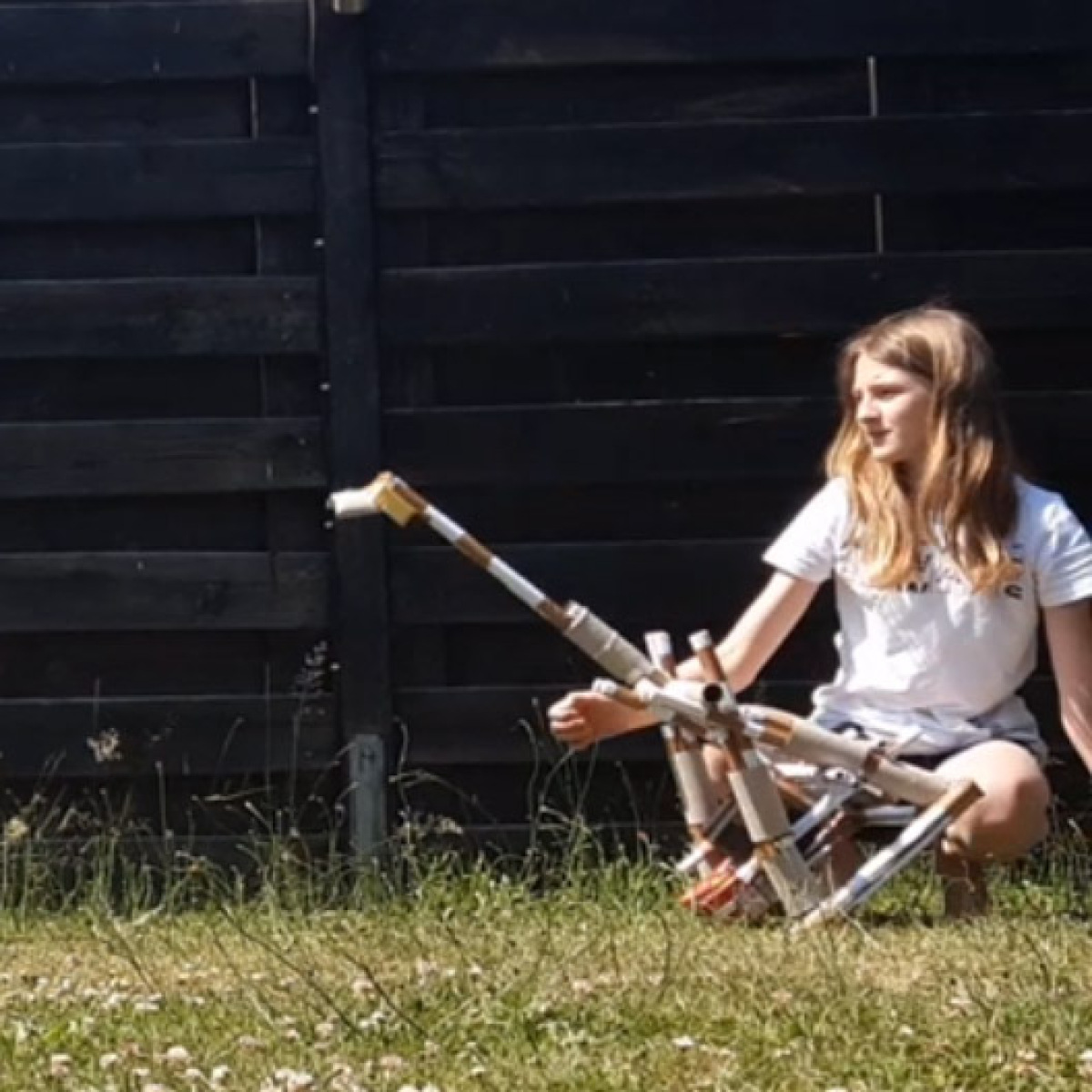
23.06.2020freestyle physics finals 2020
Nearly 50 great videos have been uploaded by imaginative students.
Just skip freestyle-physics? Not an option! Instead, quickly come up with a new task that can be done in lockdown. "You are to design, build and demonstrate a catapult with a short video that throws a ping pong ball or the empty capsule from the Ü egg as far as possible."
As always, it was a lot of fun to review the constructions. Then the tough decision - who's in first place? All the videos show catapults built with love and enthusiasm. The up-and-coming cameramen, directors, science editors, editors and presenters created true masterpieces with frame stories and outtakes.
The award ceremony then on June 19th, 2020 at 6 p.m. - not in a tent, but in the style of a web conference - published in the brand new freestyle-physics-YouTubeKanal! Of course, not only the names can be seen there, but also excerpts from the videos. Have fun watching!
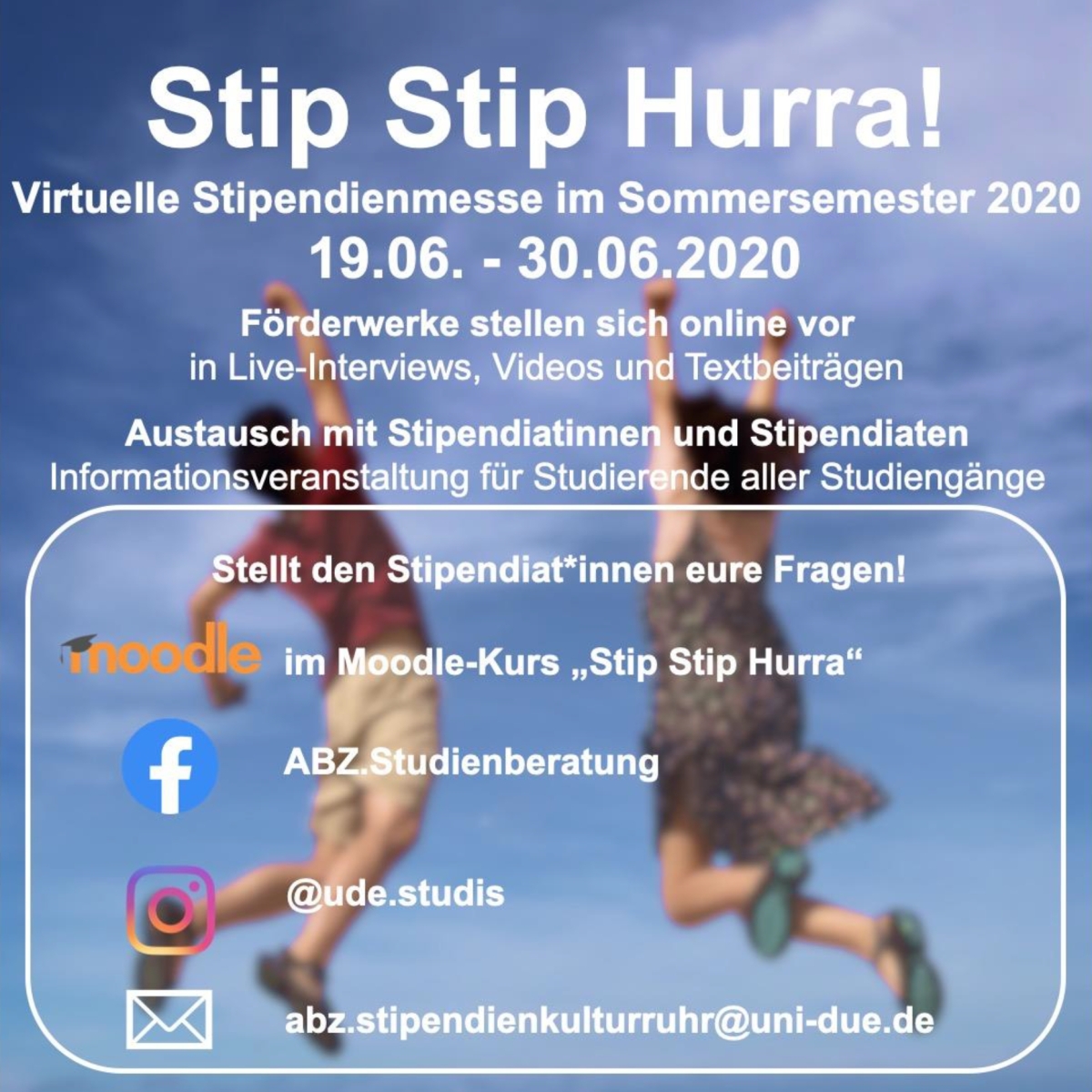
09.06.2020Scholarship Fair "Stip Stip Hurray!"
This year, the Academic Advising Center (ABZ) will once again host the "Stip Stip Hurray!" scholarship fair, where you can find out more about receiving a scholarship. This year, the event will take place from June 19 to June 30, 2020 as a virtual scholarship fair, where the individual scholarship funding organizations will present themselves in the form of live interviews, videos and text contributions.
The ABZ has set up a Moodle course room for this purpose to accompany the event. Here you can also reach the individual conference rooms of BigBlueButton, where the live interviews with scholarship holders* will take place. You can access the Moodle course room at the following link: https://moodle.uni-due.de/course/view.php?id=21487.
You can follow the scholarship fair on various platforms. There you can also ask your questions about scholarships. Information about the platforms can be found here: https://www.uni-due.de/offene-hochschule/skr_stipstiphurra.php
Your questions will be answered during the scholarship week on the above mentioned platforms. If you would like to learn more about scholarships, please also feel free to visit https://www.stipendienkultur.de/.
The ABZ looks forward to welcoming you to the virtual scholarship fair!
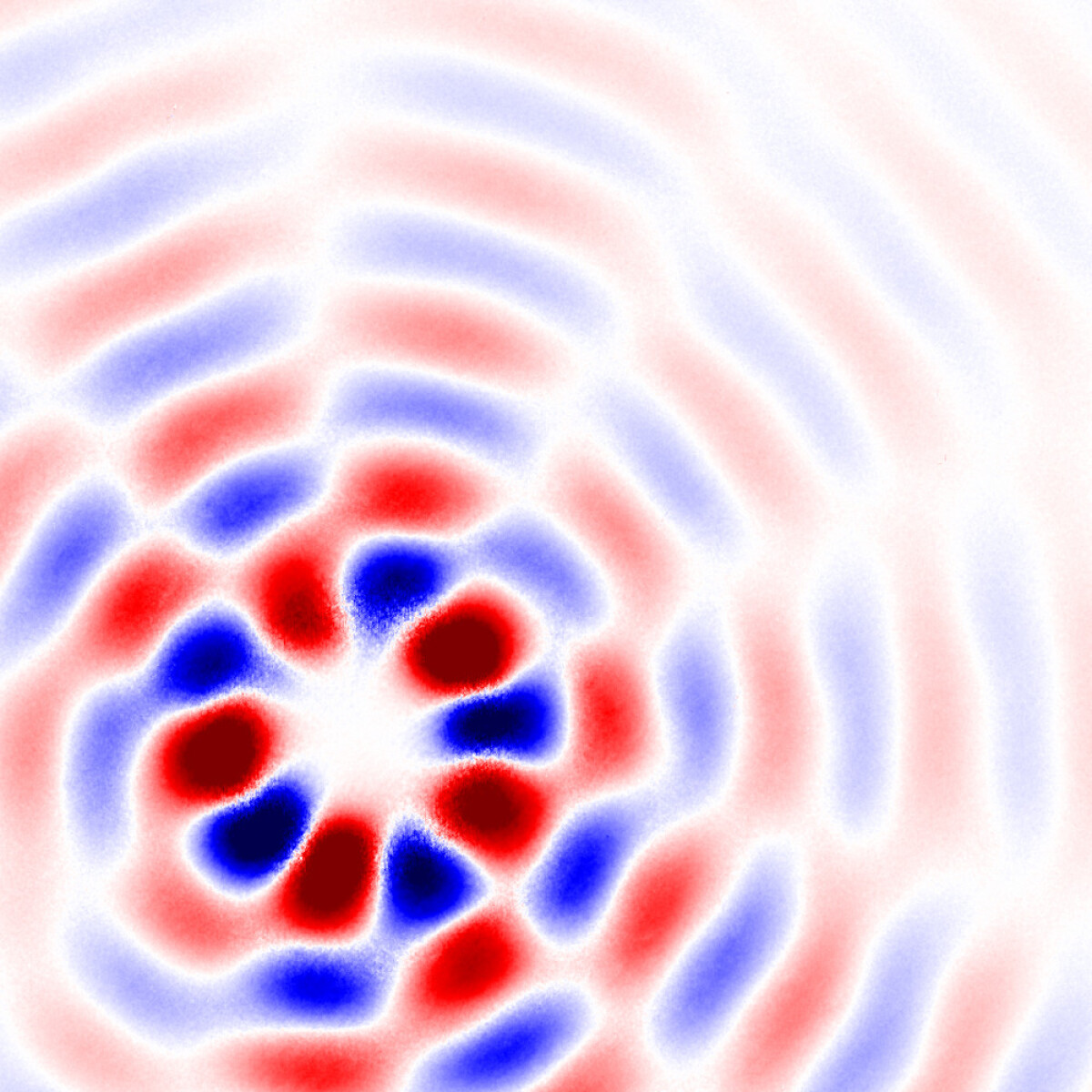
29.05.2020Physics Collaborative Research Center extended - flip book in fractions of a second
Rapid material changes and measurement techniques in the range of femtoseconds: These are the core aspects of the Collaborative Research Center 1242 of the Faculty of Physics at the University of Duisburg-Essen (UDE). The German Research Foundation (DFG) is funding it for another four years with €12 million.
The Collaborative Research Center 1242 "Non-equilibrium Dynamics of Condensed Matter in the Time Domain" from the Faculty of Physics deals with solids and their interfaces that are excited extremely quickly by an external stimulus. The scientists observe the development of this excitation with time using measurement methods that allow the state of a sample to be tracked in individual, minute time steps. In the sum of all the steps, an overall picture of the process emerges, as in a flip book.
Can extraordinary material properties be created in this way?
This can lead to new impulses and concepts for science and for new applications. In the first funding period, the focus was on developing methods to track and understand the path from excitation back to equilibrium. "Now our goal is to specifically influence the mechanisms behind this," explains spokesperson Professor Uwe Bovensiepen. "For example, we are asking ourselves whether unusual material properties arise that occur exclusively after a brief excitation. Or whether there are material modifications that keep the excitation alive over a longer period of time
The central method used by the SFB, which cooperates closely with the Center for Nanointegration Duisburg-Essen (CENIDE), is the pump-probe method: Here, an initial ultrashort laser pulse is used to excite the system. A second, read-out laser pulse follows at variable intervals of a few attoseconds to picoseconds. If the time interval between the exciting (pump) and detecting laser pulse (probe) is increased for each approach, the sum of the data yields the temporally highly resolved sequence of the process.
Collaboration with the Interdisciplinary Center for Analytics on the Nanoscale (ICAN) is crucial here, as the instruments and specialized personnel available there enable the sophisticated preparation and characterization of the samples.
Image: Vortex formation of light: the pattern represents the electric field formed for a few femtoseconds at the center of a spiral on a gold surface when illuminated with circularly polarized light. © SFB 1242, Dreher/Janoschka
Further information:
Prof. Uwe Bovensiepen, Faculty of Physics, Tel. 0203 37 9-4566, uwe.bovensiepen@uni-due.de
Editor: Birte Vierjahn, Tel. 0203 37 9-8176, birte.vierjahn@uni-due.de
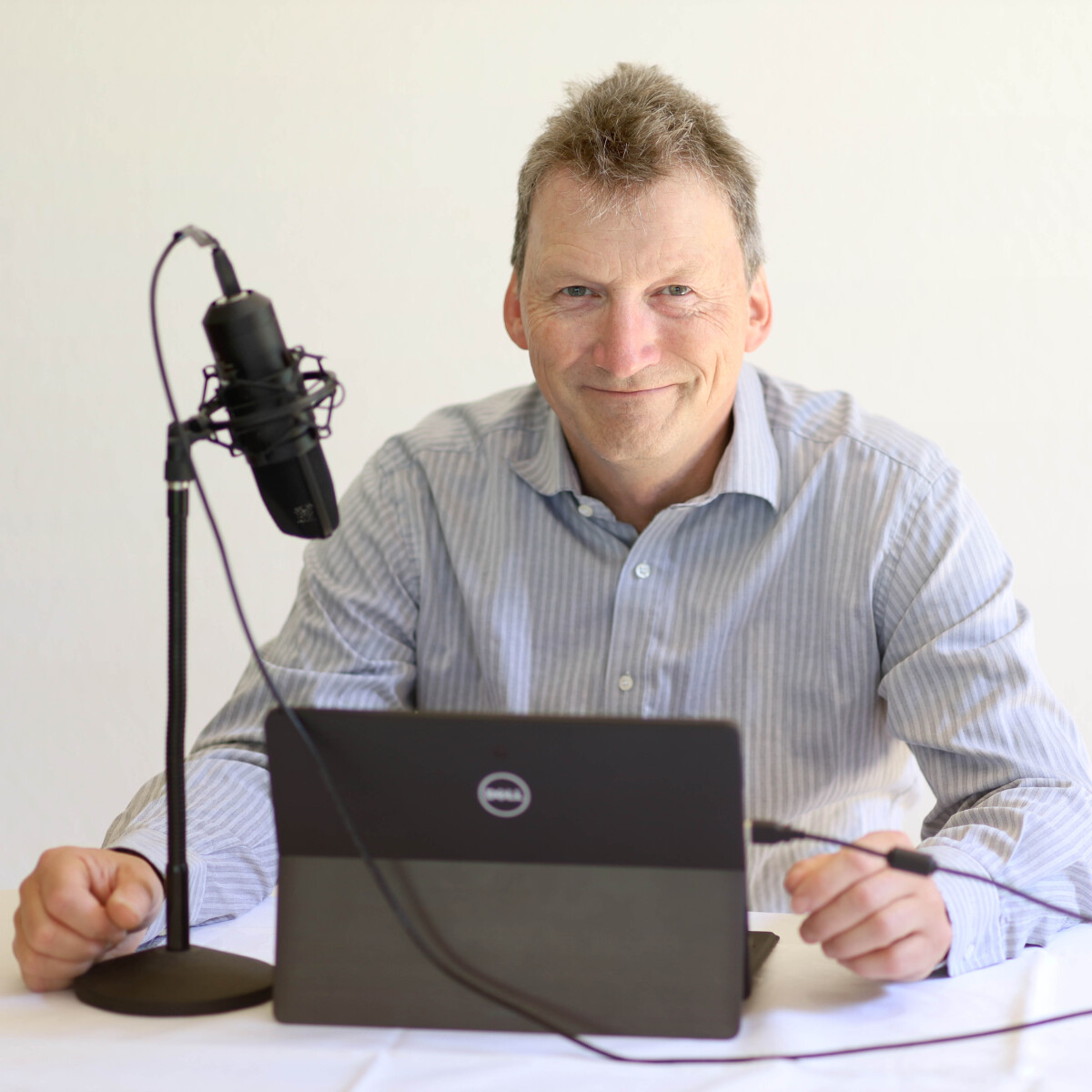
27.05.2020Career fair parentum.online on June 18th - we will be there!
Physics or Energy Science or teaching physics, or should I study something completely different? Are you still undecided? Then you can get advice from us on June 18th, 2020, 2 to 6 p.m. at the online career fair parentum.online.
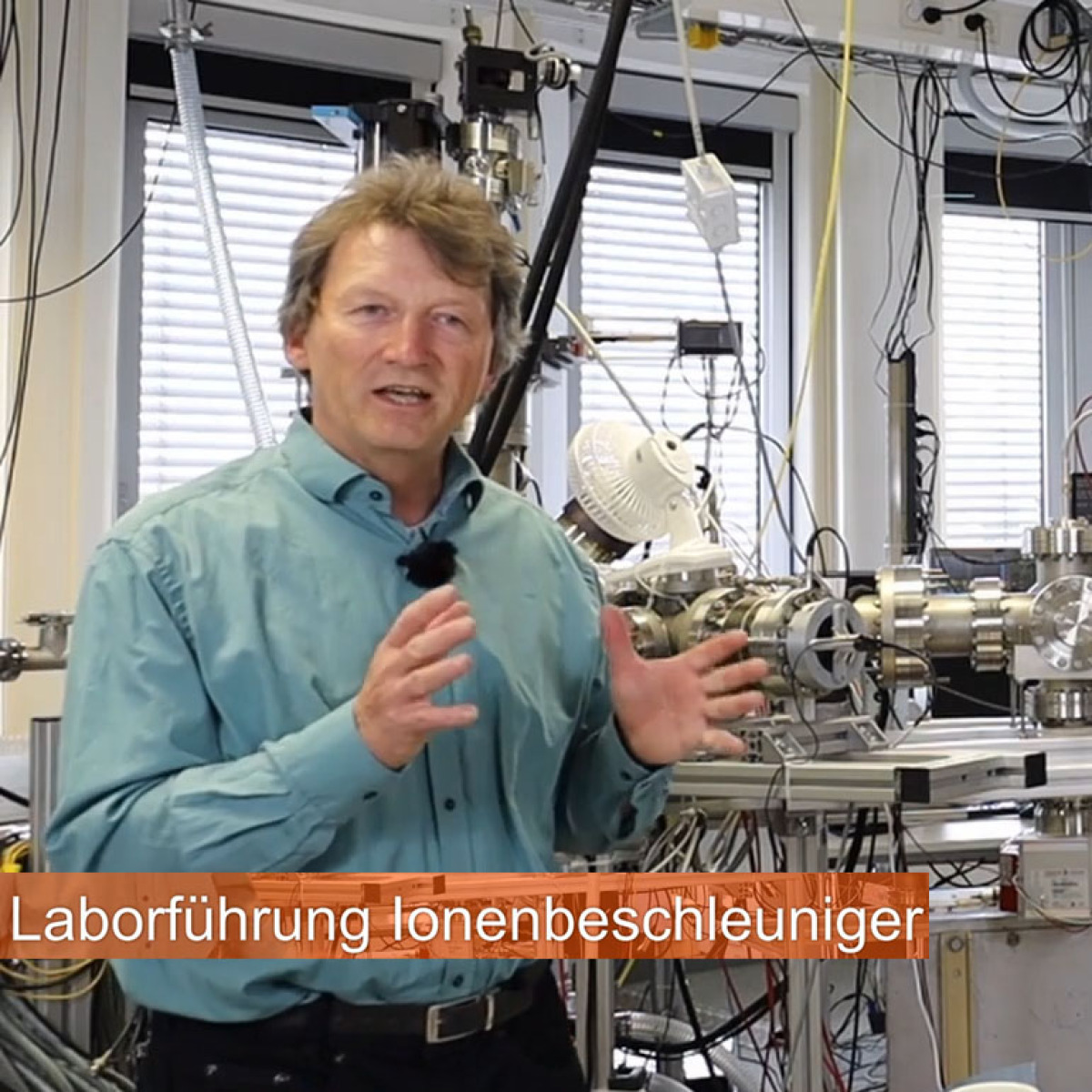
25.05.2020Video lab tour ion accelerator
Ever been in a physics lab? Not yet? Then it is about time. In the video the accelerator for highly charged ions of the research group of Prof. Dr. Marika Schleberger is introduced. Besides, you will learn a lot about life during the study of physics and how research actually works.
18.05.2020Physics Students in the Lab@Home - Half Glasses and Strudel Paper
What strange mail! There's a hodgepodge of magnets, pieces of tin, a wooden stick, a steel nib, a nail and graph paper in one envelope, and half a pair of glasses with sandwich paper in another. Has someone emptied his drawers? A glance at the sender ..., it's the physics department of the UDE. It has sent 200 such envelopes to its students - for home experiments. Some even contained something "real": an optics kit.
In the natural sciences, experiments are indispensable. Now, however, the laboratories are closed for teaching, which is why physics is helping itself - with interactive screen experiments and the Lab@Home: the home as a research workshop.
"The students in the elementary school subject of science use the contents of the envelope to test the properties of magnets and the stretching behavior of a spring, for example. Or they take a carton of Tetra Pak and a flashlight to trace light guides," says Professor Heike Theyßen, describing some of the tasks. Aspiring physics teachers, on the other hand, have to build a pinhole camera out of a piece of eyeglasses and a piece of sandwich paper. "They learn how to use simple ideas to convey exciting physics without it immediately ending in frontal teaching."
All experiments must be documented with videos and photos and sent to the instructors. The students are supported via the Moodle teaching platform, where various forums have been set up for chats and video meetings.
The optics kit (lenses, polarizers, and a grating for spectroscopic studies) is a case for chemistry and medical biology students. They have homework on geometrical optics and wave optics, and must make independent measurements and scientific statements.
"Many optical phenomena can be observed at home with simple tools. Of course, it's a bit tricky and takes time, " says Dr. Oliver Schöps. "The students have really good ideas; sometimes they even surprise us with variants we hadn't thought of."
Incidentally, a popular experiment among the prospective elementary school teachers is one on the recoil principle: a balloon has to be catapulted through the garden on a string:
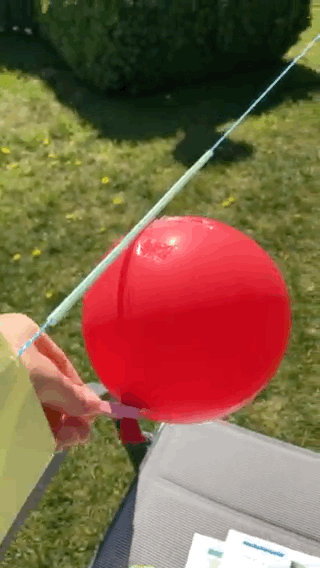
In the picture on the left:
Lecturer Dr. Andreas Reichert bagging homework.
Further information:
Prof. Dr. Heike Theyßen, Didactics of Physics, heike.theyssen@uni-due.de
Dr. Oliver Schöps, Experimental Physics, oliver.schoeps@uni-due.de
Editor: Ulrike Bohnsack, Tel. 0203/37 9-2429, ulrike.bohnsack@uni-due.de
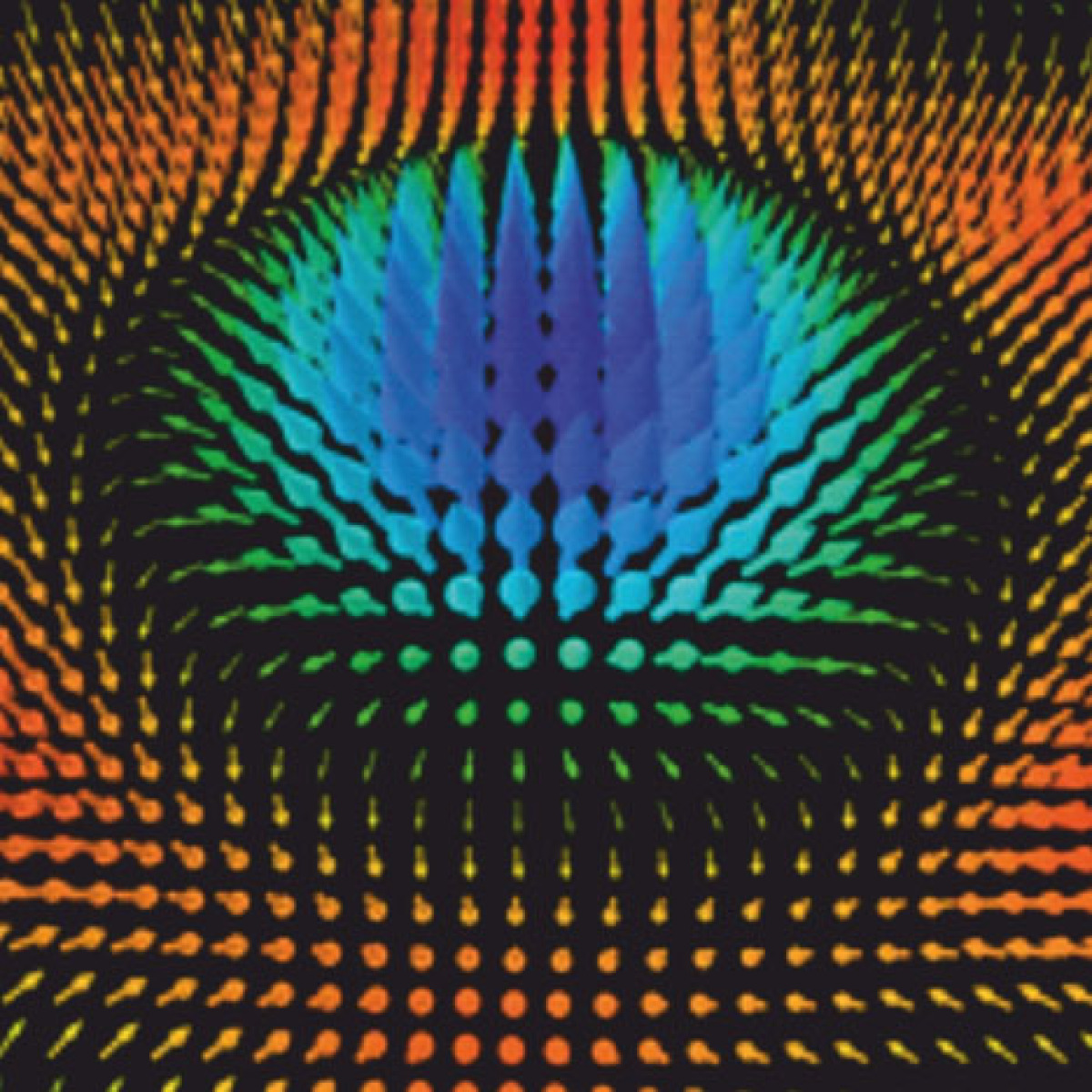
23.04.2020 Science Publication on New Technology - Changing Material Properties by Stretching
The duration of their snapshot relates to one second as one second relates to the age of the universe: In a joint collaboration with Australian Scientist Tim Davis and the Group around Harald Gießen from Stuttgart, Physicists from the Center for Nanointegration (CENIDE) at the University of Duisburg-Essen (UDE) have developed ultrafast vector microscopy as a way of determining electric fields on surfaces with high temporal and spatial resolution. The new method was used to measure the dynamics of optical skyrmions in the time domain for the first time. The renowned journal "Science" publishes this breakthrough in nanooptics in its current issue.
Figure: Graphical representation of an optical skyrmion, at a time when the electric field in the center points out of the surface. The width of the image corresponds approximately to one plasmon wavelength, i.e., 780 nanometers.
T.J. Davis, David Janoschka, Pascal Dreher, Bettina Frank, Frank-J. Meyer zu Heringdorf, and Harald Gießen: Ultrafast vector imaging of plasmonic skyrmion dynamics with deep subwavelength resolution, Science (2020)
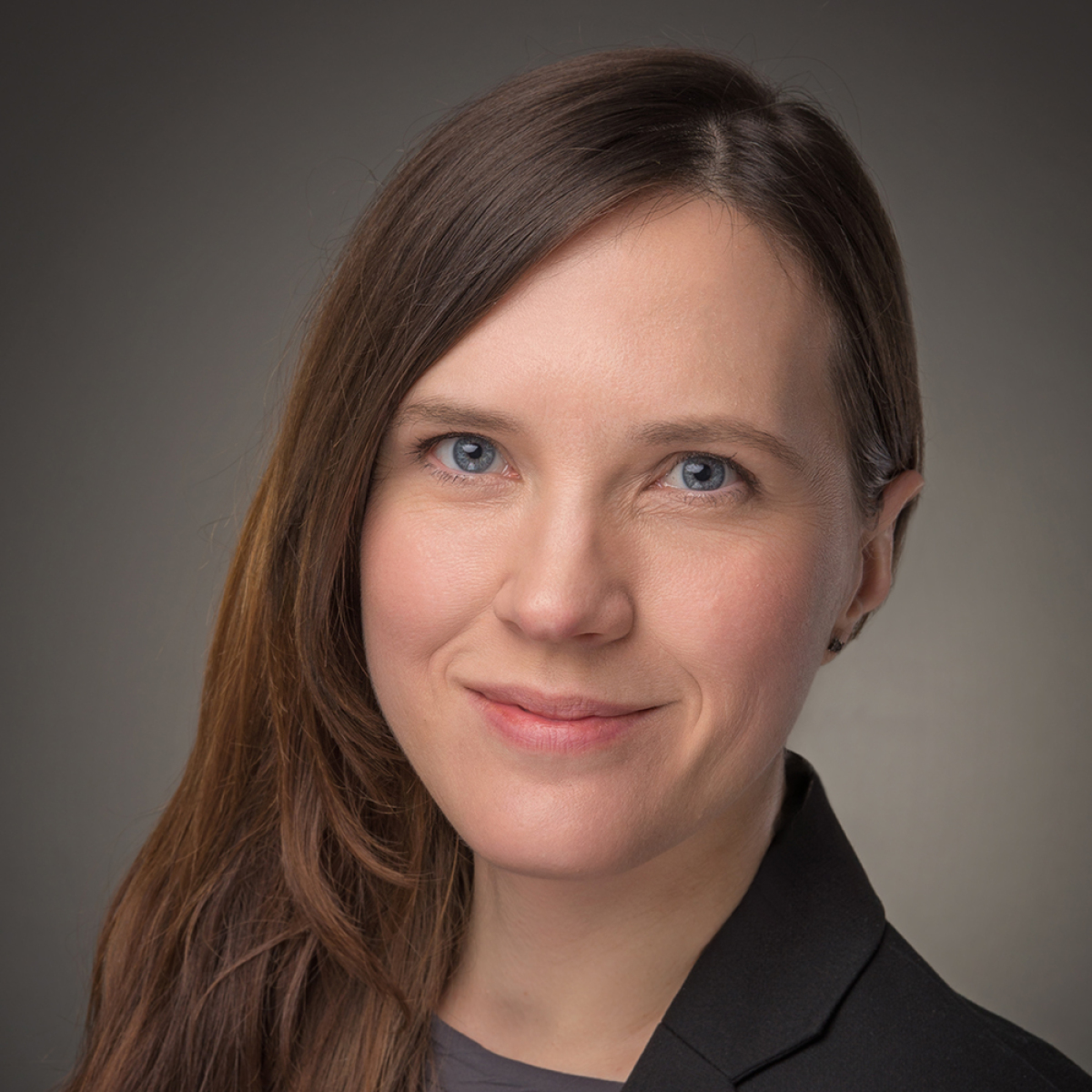
20.04.2020This is how "Home-Uni" works in the digital semester
Shortly before the start of the semester, the Funke Mediengruppe podcast "Nah und direkt" on the topic of Corona in NRW covered the topic of "How "Home-Uni" works in the digital semester". In the second half of the podcast, Dr. Anne-Kristin Pusch - study program coordinator in our faculty - provides information about the current status of our online and e-learning activities.
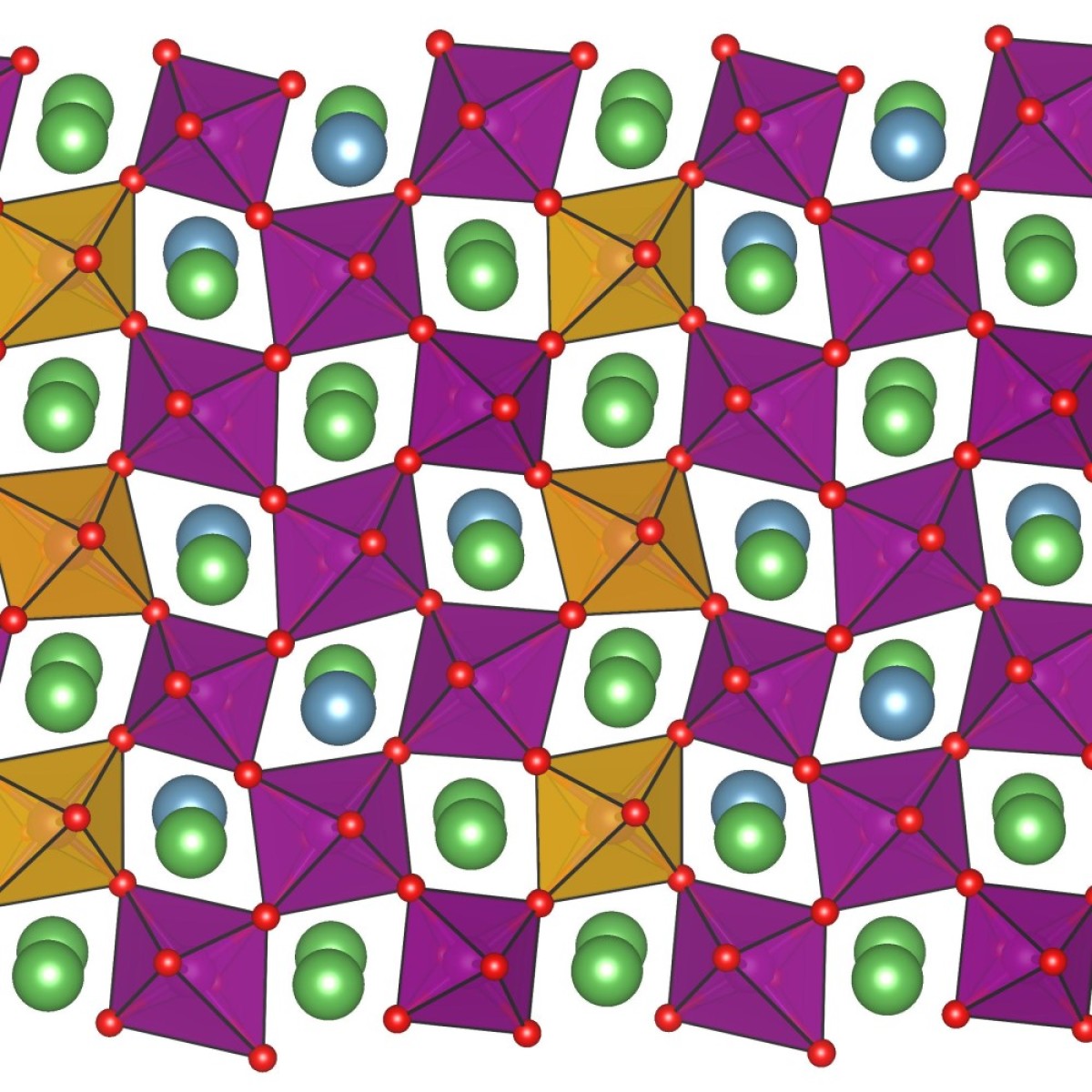
16.04.2020 Science Publication on New Technology - Changing Material Properties by Stretching
Unlike ductile metals, oxides are ceramics, known to be brittle and unable to sustain large strains. An international team of scientists, including theoretical physicists from the UDE, were successful in achieving extreme strains of up to 8 percent in oxide membranes.
When atoms are pulled away from each other, electrons can localize, thereby leading to unexpected behavior such as a metal-to-insulator transition. This breakthrough, published in "Science”, can serve to selectively design novel functionality in materials – for sensors or detectors, for example.
In collaboration with colleagues from Northwestern University (US), Manish Verma and Professor Rossitza Pentcheva have explored the origin and underlying mechanisms for the behavior of lanthanum calcium manganese oxide (La1-xCaxMnO3, LCMO) under extreme strains using large scale density functional theory calculations. The physicists were able to show that while LCMO normally is metallic and ferromagnetic, under tensile strain of 5% it switches to an insulator with antiferromagnetic order, characterized by a stripe-type of charge order of Mn3+ and Mn4+ ions.
The statistical distribution of the lanthanum and calcium ions required large simulation cells, the calculations were therefore carried out on UDE's high-performance computer "MagnitUDE".
Image: Charge-ordered phase of the lanthanum calcium manganese oxide.
Original Publication: Seung Sae Hong et al., Science, 5 April 2020
Further Information:
Prof. Dr. Rossitza Pentcheva, Computational Materials Physics, +49 203 37 9-2238, rossitza.pentcheva@uni-due.de
Editor: Birte Vierjahn, +49 203 37 9-8176, birte.vierjahn@uni-due.de
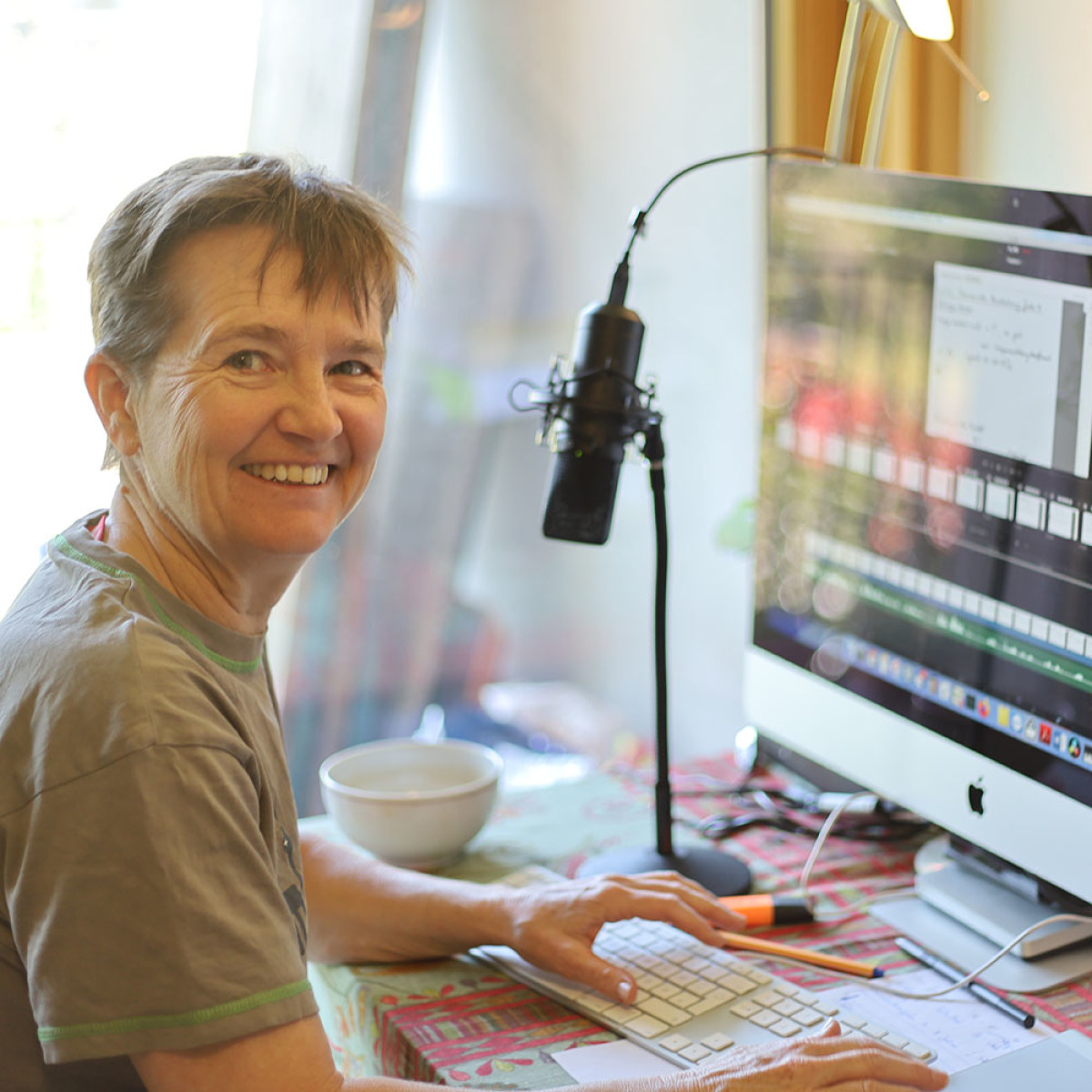
15.04.2020Final preparations are in full swing!
On Monday, April 20th, things get exciting - the semester begins under completely new conditions. The final preparations for the online and e-learning formats are in full swing. Various video conferencing programs are being put through their paces everywhere. Videos are recorded, PowerPoint presentations are set to music, experiments are filmed, edited and set to music. Care packages are even made up for students with all sorts of things for experiments.
The specially set up homepage for information from the Faculty of Physics on COVID-19 shows in an impressive way the challenge facing the professors and other teachers on the one hand, and the students on the other. The mood is good - everyone is excited to see how we can use the potential offered by digital teaching to at least partially replace the lectures we are used to.
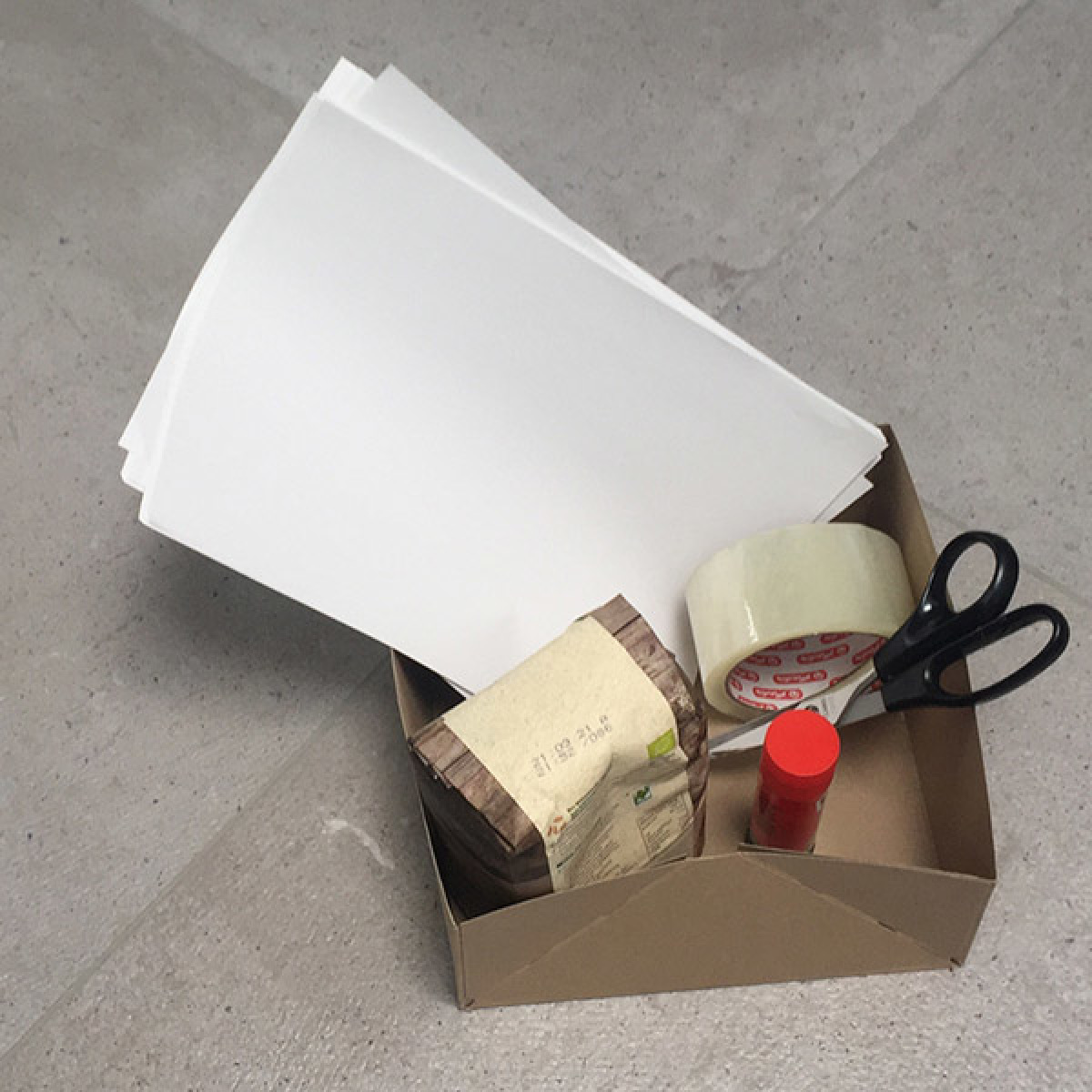
03.04.2020freestyle-physics as a video competition - build a catapult!
Unfortunately, this year there will be no more self-invented solar ovens, paper bridges and footballs that roll by themselves. The big freestyle-physics competition, which brings 2,000 boys and girls to the UDE every year, has been cancelled. Wait a minute. It's not quite like that: You're allowed to tinker with a task. At home, of course, and with things that are certainly available. What is it about? Build a cardboard catapult!
"Many children and young people just do not know what to do all day. So we came up with a tricky task for the home that doesn't require much in the way of supplies," says Andreas Reichert.
Only paper, cardboard or corrugated cardboard, paper glue and adhesive tape may be used for the construction. Neither springs nor explosions nor anything similar are allowed as a drive; the drive weight may only be 500 grams - "as much as, for example, a bag of flour or a plastic bottle containing half a liter of water," says Reichert. The finished throwing machine is then supposed to hurl a table tennis ball or the empty yellow capsule of an Ü-egg as far as possible.
Construction and building of the catapult as well as a shot are to be filmed. The video must be uploaded to the freestyle-physics website by June 15th. The jury will evaluate implementation, originality, range of shots and presentation.
Reichert emphasizes: "As long as the contact ban is in place, please stick to it. So if you are exchanging with your friends, do it by phone or Skype."
Instructions for uploading the video are available at info@freestyle-physics.de.
Editor: Ulrike Bohnsack, Tel. 0203/37 9-2429, ulrike.bohnsack@uni-due.de
30.03.2020freestyle-physics 2020 unfortunately has to be cancelled!
The Ministry for Schools and Education of the State of North Rhine-Westphalia has prohibited schools in NRW from conducting school trips and participating in school events at extracurricular learning venues.
This means that freestyle-physics 2020 cannot take place in the planned form. We are therefore cancelling the 2020 competition. The tasks will be carried over into next year. Hopefully, the work that many of you have already put into the competition will not be in vain.
The team is currently thinking intensively about a virtual form of the competition, which of course must be compliant with the applicable distance rules.
06.03.2020WiSA - Big Data in Wind Energy - How Digitization Can Make Wind Power Cheaper
Interdisciplinary research team develops virtual assistant for wind farms
The research project WiSA big data ("Wind farm virtual Site Assistant for O&M decision support - advanced methods for big data analysis"), which is funded by the German Federal Ministry for Economic Affairs and Energy (BMWi) with a total of 2.6 million euros over a period of three years, started at the beginning of December. As part of WiSA big data, scientists are working with partners from industry to analyze large volumes of high-resolution operational data from wind turbines. New and extended analysis methods are intended to help detect errors in the operation of wind turbines at an early stage and to optimize the maintenance of the turbines.
In WiSA big data, the project consortium aims to bridge the gap between sound methodological research and testing in industrial applications. The Guhr working group of the Faculty of Physics at the University of Duisburg-Essen will attempt to find quasi-stationary states of wind turbines and entire wind farms in the dynamically changing correlation structure of the data.
Participants in WiSA big data are the University of Oldenburg with three groups, the University of Duisburg-Essen with the AG Guhr, the Fraunhofer Institute for Wind Energy Systems IWES, the Institute of Computer Science OFFIS e.V., Ramboll Deutschland GmbH, Ocean Breeze Energy GmbH & Co. KG and Deutsche Windtechnik X-Service GmbH.
The project consortium is supported by associated partners Vattenfall Europe Windkraft GmbH and ADDITIVE Soft- und Hardware für Technik und Wissenschaft GmbH, among others.
18.02.2020New in the faculty: Martin Mittendorff - Time-resolved research
Our world exists in 3D. But not everything bows to this scale. The new professor of experimental physics, Dr. Martin Mittendorff, is investigating, for example, what lies in ultra-thin 2D materials. Methodically, he uses terahertz spectroscopy at the UDE for this purpose.
Terahertz radiation (THz) is an electromagnetic wave between microwaves and infrared radiation. With THz spectroscopy, Professor Mittendorff observes time-resolved material samples. "The short THz pulses allow us to study with high temporal resolution how fast electrons release their energy to the environment," says the 40-year-old. Depending on the material, this is in the picosecond range (0.0000000001s), imperceptible to human perception of time. This knowledge is important, among other things, for fast detectors of infrared radiation, which are necessary, for example, for optical information transmission, e.g., via optical fiber.
In 2D materials, Mittendorff focuses on atomically thin layers such as carbon graphene. It is regarded as the electronic wonder drug of the 21st century, is highly conductive and extremely tear-resistant. Graphene is used, for example, as a thin layer in touchscreens, for thermal insulation or to make plastics stronger. Professor Mittendorff excites it in experiments with a so-called ultrashort pulse laser, which emits laser light in an extremely short time.
Martin Mittendorff got his first taste of technical physics in 2001 with the German Armed Forces, where he was trained as a calibrator and tested physical measuring equipment until 2006. From 2006 to 2010, he studied optotechnology and image processing at Darmstadt University of Applied Sciences. He then moved to Helmholtz-Zentrum Dresden (2010-2014), where he received his PhD with very good results in 2014. He then conducted research at the U.S. University of Maryland, among other institutions, until 2017.
Further information:
Prof. Dr. rer. nat. Martin Mittendorff, Experimental Physics, Tel. 0203/37-92273, martin.mittendorff@uni-due.de
Editor: Alexandra Nießen, Tel. 0203/37-91487, alexandra.niessen@uni-due.de
18.02.2020Tasks for freestyle-physics online - starting signal for tinkering
A soccer ball that rolls by itself - that's what the European Championship would be all about! What remains a dream for every elf will be technically tricky fun for schoolchildren. These and other tasks await them at the freestyle physics of the UDE. Registrations are open until June 1st.
Teams from grades 5 to 13 have until the summer to come up with creative solutions to these exciting tasks using their brains and zeal:
- Self-running soccer ball: A self-built construction ensures that the ball moves independently in a predetermined direction.
- Hovercraft: It moves along a measured distance of one meter while keeping a travel time of 10 seconds as accurately as possible.
- Folding paper bridge: A foldable, extendable or dismountable bridge with minimal dead weight is to bridge a distance of 80 cm while supporting a weight of 400 g placed in the center of the bridge.
- Solar oven: A given amount of water is heated as effectively as possible with thermal radiation. An infrared radiator with 100 watts of power serves as the "standard sun" for this purpose.
- Water rocket: Water and 5 bar pressure must be sufficient to launch a PET bottle converted into a rocket as rapidly as possible and keep it in the air for a long time.
What the 2,000 boys and girls come up with will be judged by a jury from June 15 to 19 at the Duisburg campus. The young physicists will receive special prizes for particularly creative or original solutions.
Further information:
Dr. Andreas Reichert, Physics, Tel. 0203/37 92032, andreas.reichert@uni-due.de
Editorial office: Cathrin Becker, Tel. 0203/37 91488, cathrin.becker@uni-due.de
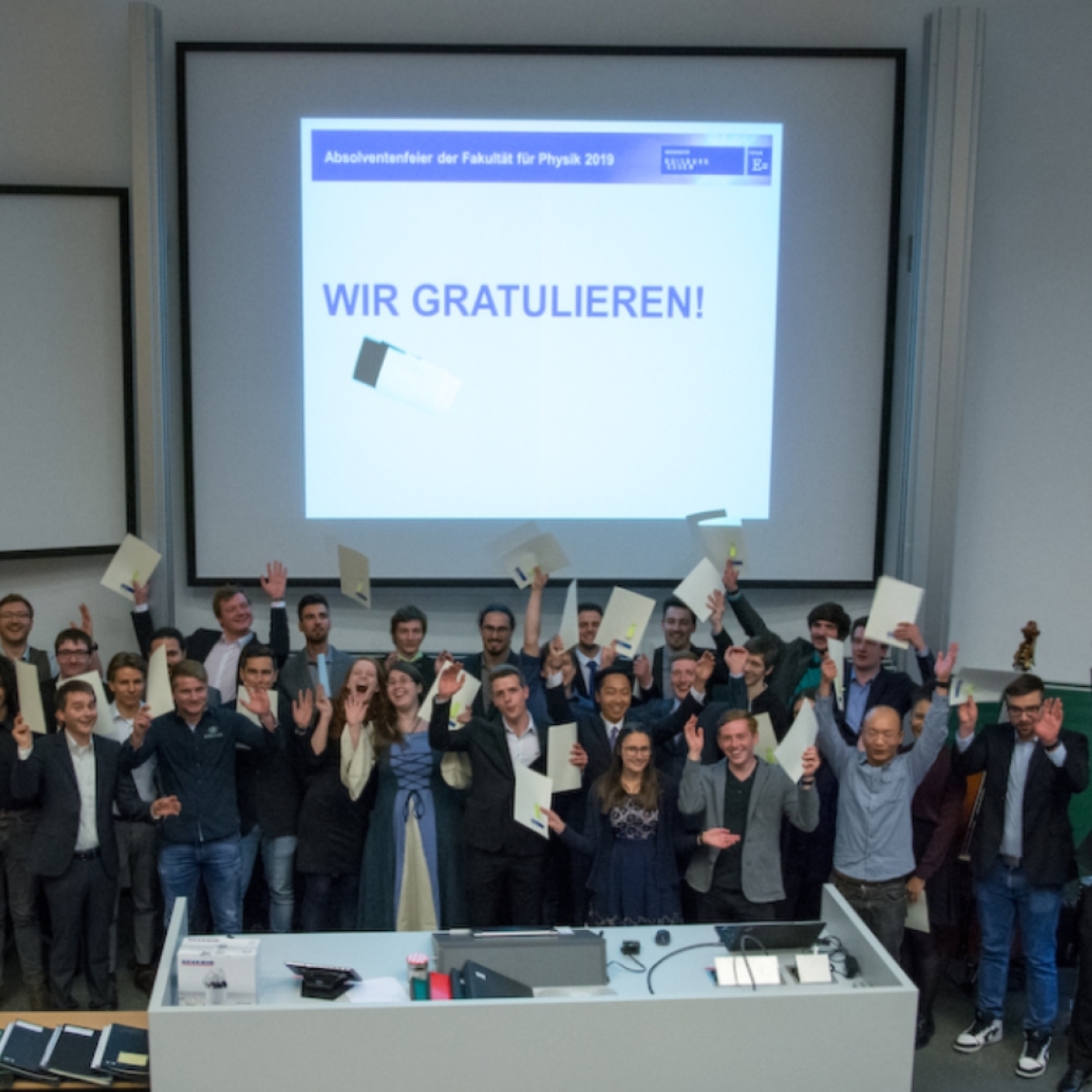
18.02.2020Graduation ceremony postponed to 2021
Due to COVID-19, the graduation ceremony of the Faculty of Physics is postponed to 2021. The exact date will be fixed and published at a later date.

12.02.2020CRC 1242 Review panel meeting on February 13th to 14th, 2020 in Duisburg
Program Thursday, February 13th:
- 10 a.m. – 12:30 p.m. Opening plenary session Presentation of the CRC, Room MD 162
- 1 p.m. – 4 p.m. Poster Session, Foyer MD 162
Guests are welcome
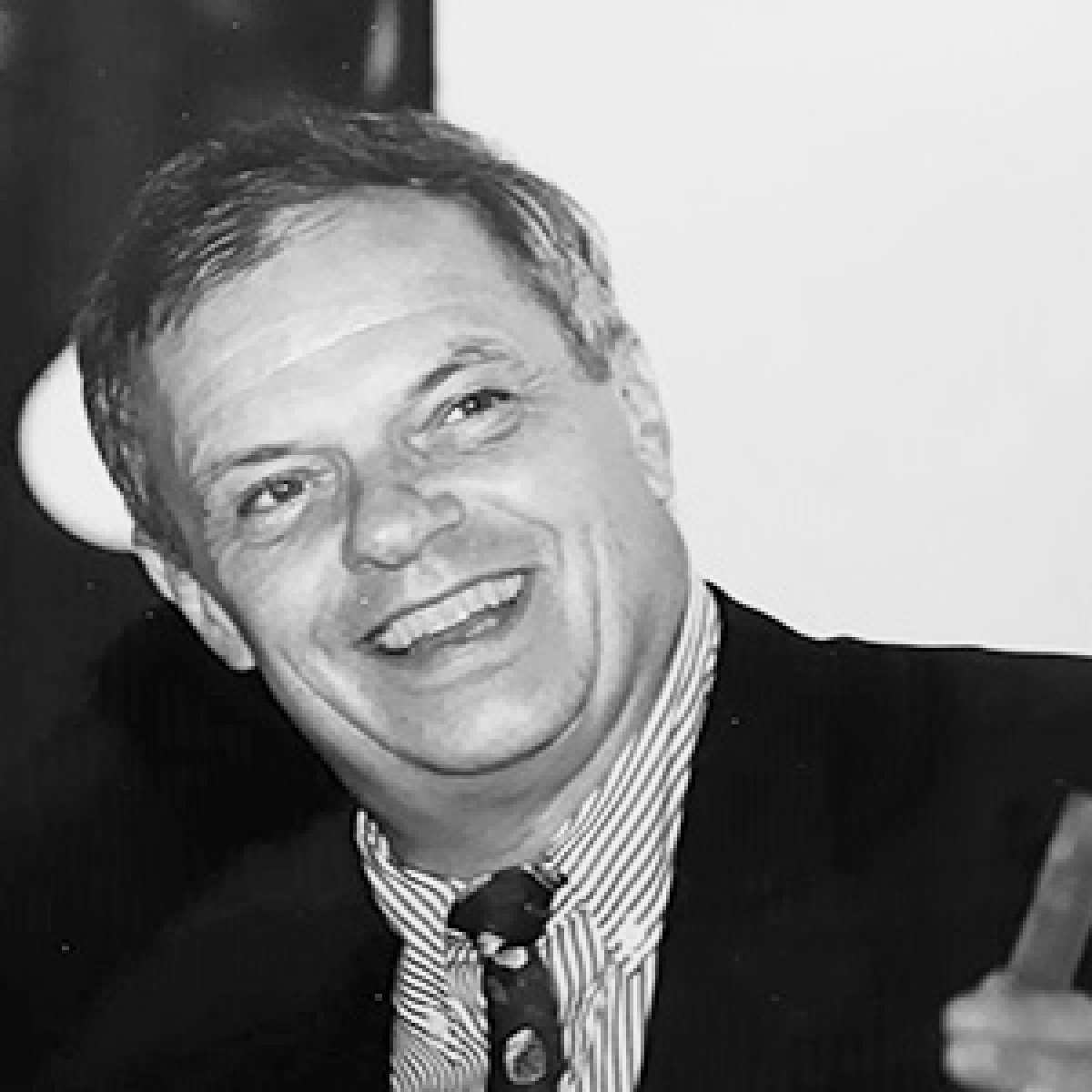
10.02.2020Obituary for Prof. em. Eberhard Wassermann - Mourning for specialists for magnetic materials
Researching magnetism and the scientific discussion (not only) on this topic were his passion: As a founding member of the then Gerhard-Mercator Gesamthochschule Duisburg, today's University of Duisburg-Essen (UDE), Professor Eberhard Friedrich Wassermann remained true to it from 1976 until his retirement in 2002. The expert in cryogenic physics died at the end of January at the age of 82.
"As a man and a scientist, Eberhard Wassermann was a great personality, always full of energy, drive and assertiveness, sometimes rough and controversial, but also of rousing enthusiasm for research and always connected with the good of magnetism and solid state physics. We are losing a great researcher and a wonderful person," says Prof. Michael Farle for the faculty. "We miss him, and he remains unforgotten to us - as he himself so often said about others."
Born in 1937, Eberhard Wassermann studied physics at the University of Göttingen from 1957 and graduated in 1963. He received his doctorate just two years later under the supervision of Rudolf Hilsch, the supervisor of the doctoral program. As a post-doctoral fellow, he was a research assistant at Northwestern University (Illinois, USA) and, from 1967, a research assistant at RWTH Aachen University under Wilhelm Sander, where he habilitated in 1970 and became Professor of Experimental Physics. From 1976 to 2002, he held the chair of low temperature physics in Duisburg, Germany, where he focused on magnetic materials and magnetism. In addition, he was chairman of the professional association and the working group "Magnetism" of the German Physical Society (DPG) for many years.
Commitment to the sciences and their communication
In his research, he was concerned, among other things, with the relationship between structure and magnetism of three-dimensional alloys, magnetic shape memory of alloys and magnetic nanoparticles.
Wassermann was significantly involved in four Collaborative Research Centres, in some cases as spokesman. For example, he coordinated programs whose fundamental scientific results have contributed significantly to new developments of magnetic materials in medical technology, sensor technology and electromobility.
Together with his former doctoral student and current science journalist Dr. Axel Carl, he has organized the science festival "Highlights of Physics" organized by the Federal Ministry of Research and Technology since 2002. "For their outstanding services in making the fascination of physics accessible to a broad public," both were awarded the Medal for Scientific Journalism of the DPG in 2007. In 2010, Wassermann was awarded the DPG's golden needle of honor.
Editor: Birte Vierjahn, Tel. 0203/37 9-2427, birte.vierjahn@uni-due.de
06.02.2020Want to discover MINT?
Learning during the summer vacations? Can also be exciting! From August 3rd to 7th, the UDE will again be offering experiments, lectures, exercises and excursions for young people aged 15 and over. You can now register online for the Summer University (SUNI) in Natural and Engineering Sciences.
How many infinities are there actually? Is it possible to print components, and how is a robot programmed? If you enjoy discovering the answers, SUNI is the right place for you. There are 120 places, divided fairly for girls and boys. In order to address them specifically and to get them excited about studying MINT, most events are separated according to gender.
During the project week, the young people gain a realistic insight into the various fields of study and experience everyday university life at first hand. In addition, they receive basic information that makes it easier for them to choose a course of study and a career: student tutors provide them with insider knowledge, the student advisory service provides information about admission requirements and financing of studies, and experienced engineers and natural scientists from business and industry can be looked over the shoulder of future specialists.
The SUNI costs 35 euros, including daily meals in the refectory. Those who have a long journey can stay overnight in the youth hostel, for example.
Contact:
Academic Advice Center Studies and Career ABZ: Silke Gramsch & Markus Krämer, sommeruni@uni-due.de
30.01.2020Unexpected behaviour of the material - From 2D crystal to 1D wire
No volume, not even a surface: a one-dimensional material is like a wire and has properties that are completely different to its 3D counterpart. Physicists at the University of Duisburg-Essen (UDE) have now discovered a system that, at warmer temperatures, forms self-organized wires consisting of only one row of individual atoms.
"Low-dimensional systems are en vogue", according to Professor Michael Horn-von Hoegen, experimental physicist in the UDE Collaborative Research Centre 1242 "Non-equilibrium dynamics of condensed matter in the time domain". For restricting a system of three dimensions to just one creates the possibility of discovering new properties in the material.
Therefore, the scientists used stepped surfaces to allow atomic wires to form in a self-organized way by cutting a silicon crystal at an angle of 12 degrees. Careful polishing produces even steps with a height of exactly one atom – as in the attempt to build a slanted plane using only Lego bricks of the same size. The edges of the steps are formed by silicon atoms, with two rows of gold atoms deposited behind them.
Atoms shift
The researchers are now interested in every third silicon atom in this row at the edge, because it has special properties: At very low temperatures, these atoms are arranged in a regular lattice (viewed across the steps), i.e., in a two-dimensional crystal structure. And now heat is added, a term that is quite elastic in physics: from previously -223°C, the system is now heated to around -123°C. This thermal energy causes the regular distances between the special silicon atoms to break up. They are now sometimes two, sometimes four atoms apart.
This way, independent chains of atoms are formed, which run along the edges of the steps. The fact that physicists can explain this phenomenon in detail today is due in large part to the theorist Prof. Björn Sothmann: His calculations explained what the pure experiment could not reveal.
"Here, something new emerges almost out of nowhere," Horn-von Hoegen summarises. And the result also contradicts previous expectations: "2D order at low temperatures, one-dimensional structures when it gets warmer; you don't get this kind of thing from any other material. Now we want to find out whether this also applies to other systems - maybe even at room temperature".
The highly respected scientific journal Physical Review Letters covers this in its current issue.
Photo:
Careful polishing produces even steps with a height of exactly one atom – as in the attempt to build a slanted plane using only Lego bricks of the same size.
Original publication:
B. Hafke, C. Brand, T. Witte, B. Sothmann, M. Horn-von Hoegen, S. C. Erwin:
“Thermally Induced Crossover from 2D to 1D Behavior in an Array of Atomic Wires: Silicon Dangling-Bond Solitons in Si(553)-Au”
Phys. Rev. Lett. 124, 016102 (2020)
https://doi.org/10.1103/PhysRevLett.124.016102
Further information:
Prof. Dr. Michael Horn-von Hoegen, Fakultät für Physik, +49 203 37 9-1438, horn-von-hoegen@uni-due.de
Editor: Birte Vierjahn, +49 203 37 9-8176, birte.vierjahn@uni-due.de
28.01.2020Best Teacher Award of the study program NanoEngineering goes to Prof. Dr. Marika Schleberger
On January 25th, Prof. Dr. Marika Schleberger from the Faculty of Physics was awarded the Best Teacher Award of the Nanoengineering course of study. The certificate and a glass sculpture were handed over during the graduation ceremony of the Faculty of Engineering. Ms. Schleberger repeatedly read the lecture Properties and Applications of Nanomaterials II for Future Nano-engineers in the Nanoengineering course of studies.
Students of this course of studies make an important contribution to research in the working group of Mrs. Schleberger in the context of project, bachelor and master theses. Some graduates of the program are now also doing their doctorate in physics.
08.01.2020Vocational Profile Day 2020
Graduation in Physics/Energy Science - and then?
If you also ask yourself this question, then you are welcome to the career day!
In this event, organized by the mentoring program of the University of Duisburg-Essen, four former physics students of our faculty will present their fields of work in lectures and afterwards ask your questions while enjoying food and drink!
When?
January 15th, 2020
Admission: 5:30 pm
Start of the lectures: 6 pm
From 9:30 pm open discussion
Where?
Mercator Hall
Gerhard-Mercator-Haus, Building LR 007 (Lotharstraße 57)
Contact person:
Dr. Boris Weidtmann
07.01.2020Studienstiftung des deutschen Volkes - Wende new liaison professor
Prof. Dr. Heiko Wende is now a Lecturer-in-Chief of the German National Academic Foundation. In October he was officially appointed by the Foundation's Board of Directors. The second liaison lecturer at the Duisburg campus also comes from the CENIDE network.
Each liaison lecturer supervises an interdisciplinary group of up to 15 participants who are sponsored by the German National Academic Foundation. Wende advises the scholarship holders on general questions about their studies. He currently looks after ten students from very different fields: from politics and economics to medical technology and sociology.
Once a semester, Wende, himself an alumnus of the scholarship program, meets with his group for a jointly planned venture. The interdisciplinary component of the scholarship is the main focus for him. He would like to motivate students to exchange ideas and to look beyond their own discipline. The regular meetings of the group offer an excellent opportunity for this. "I too can broaden my horizons," explains Wende. "Getting to know other interests and subject areas is the most exciting part of it.
Currently, two members of CENIDE are appointed as liaison lecturers at the UDE Duisburg campus: In addition to Wende, head of the "Magnetic Nanostructures" working group in physics, Prof. Dr. Roland Schmechel, head of the "Nanostructure Technology" working group from the engineering sciences, is also there for the scholarship holders. Wende had taken over the office from Prof. Dr. Marika Schleberger.
The Studienstiftung des deutschen Volkes is the oldest and largest organization for the promotion of gifted students in Germany. It supports students who achieve excellent academic performance and are also socially committed.
Further information:
Prof. Dr. Heiko Wende, Tel. 0203 37 9-2838, heiko.wende@uni-due.de
Editor: Jan Jerig


